
Бесплатный фрагмент - Digital transformation for chiefs and owners. Volume 2. Systems thinking
Foreword
If you are reading this book, you probably already understand what digital transformation is, why it is needed, and you have the realization that change is indispensable.
As I said in the first book, digital transformation is a management tool and a global redesign of the business model and the entire management system.
But what do you think I face personally in life? It is banal with the fact that there is no system, but there is either complete chaos and dependence on personalities (at best), or bureaucracy with the suppression of any personalities.
The book will focus on the implementation of a systems approach to management, without which any transformation will be a simulation.
I do not insist on the truth in the last instance, but every time such an approach was applied at least partially, the result amazed even me!
Do you think it’s possible from a community where no one wants anything to build a team with exemplary discipline to triple their productivity in three months? I will answer «yes» because I have achieved this result.
But to do that, first person involvement is needed. And without accumulated dissatisfaction with the situation and political will, all other manipulations and tools are meaningless.
We will go through the areas of the system approach, find out what key tools are needed for its implementation, what global practices already exist, and explore practical cases.
Therefore, what is the systemic approach I am promoting?
It is built on a combination of:
— Lean Manufacturing
Its mission is to continuously improve, eliminate losses, including through the use of digital technologies. Allows you to determine the objectives of the implementation of the figure, to build tactics.
— Project Management
Allows to minimize risks and budget.
— Using the product approach
Digital transformation must be accompanied by the creation of new products. Additionally, without the basic tools of food management, it’s almost a guaranteed failure. Additionally, then you won’t just be disappointed, you might end up on the verge of bankruptcy.
— System constraint theories
It allows for prioritization so that efficiency gains can be achieved with less investment. For example, a project for 3 million rubles, aimed at increasing productivity by 3 times, when applying the theory of system limitations, allows to reduce the budget to 1 million rubles, while receiving a 2.5-fold increase in productivity.
— Introduction of Changes
Digital transformation is about people and processes. The application of the main tools for implementing changes minimizes risks, resistance and the likelihood of a setback.
— Managing communication between units
Communication between units is a secret ingredient of both success and failure. Digital transformation is absolutely about the same — the ability to sit down, negotiate, hear each other. In my practice, all crises or problem projects / companies have one problem on the basis — cannot agree or do not hear each other, especially the top managers of their subordinates.
In general, working with SEO’s is very difficult. As a rule, these are people so-called «E-type» by Adises: entrepreneurs, bright and strong personalities, authoritarian, do not tolerate opinions different from their own.
These qualities help build companies, overcome the first problems — thanks to stubbornness, perseverance, authoritarianism, but then it begins to hinder business growth.
From this there is such a principle in management: centralization of power is needed at the start and at the collapse of the system, but for development decentralization is needed.
Which means the decision maker needs to change. However, when this man reaches the heights, he becomes stale, loses his former flexibility: he has gone the way, proved his worth, and now it is very difficult to recognize the need to change for further growth or the correctness of others’ opinions.
Now, can you imagine how a strong person like that would learn to detach from manual control?
— Using Digital Technologies and Data for Decision-Making
The first book was essentially devoted to this section. Digital transformation involves the active use of digital tools and analytics to minimize risks, create new products.
— Regular management practices
Digital technology will not fix chaotic controls, blurred targets, toxic communication, lack of control points. These are only tools that need the master’s hands.
— Working with strategy, organizational structure and business processes
Organizational structure and business processes are the foundation of an organization that supports the achievement of strategic goals. But they (structure, processes, strategy) are not eternal and must change over time.
Digitalization and digital transformation must become your strategic goal in order to «top» initiate all other changes.
Org. The structure aims to achieve the goals of the company by providing the necessary people with resources and dividing areas of responsibility.
When changing goals, strategies, available technologies (resources), you need to change the structure, allocation of resources and authority.
Therefore, you can shape the book’s message: digital transformation is one of the tools to achieve the goal; you can’t just implement one tool and hope that it will dramatically improve efficiency — you need integrated work.
Is it possible to master the whole approach one person? With due perseverance and consistency for 10—15 years — yes. Of course, no one has that much time, so the only way is to form a team with the right competencies.
Therefore, this book will be useful for both top managers of large organizations that can build work with middle managers, and managers of small companies.
P.S. This is the second edition of the book. In addition to minor adjustments to the original material, it is supplemented by two new chapters — what to teach staff and to what level, and a roadmap for digitalization and digital transformation. Practical examples of sharing systems approach tools have also been added.
Chapter 1. Organizational Structure and Business Processes
We will start with the organizational structure and work with business processes. If you translate into everyday language, org. The structure is the skeleton of the company, and the described, streamlined and efficient business processes are the nervous system.
The organizational structure is the basis for the management system. It achieves the company’s goals by providing resources to needed people and delineating areas of responsibility.
Additionally, when you have new technologies, changing goals, the company «matures» and moves to a new level, then business processes with organizational structure should change.
A clear and visualized organizational structure is a MUST. In my practice, there has never been a single case of a company operating smoothly without the organizational structure described, accessible and understandable to all.
Most often I observe the following:
1. There is no organizational structure. This is acceptable if you are 2—3 people, you are a strong manager and you have a strong team, you know how to negotiate among themselves. Otherwise, it is a realm of chaos. Even if you have the processes described.
2. The organizational structure is on paper, but in life quite differently. As they say, «waiting is reality».
3. There is an organizational structure, but it has no information about functions, powers, responsibilities. It’s not synchronized with the company’s goals, it’s not confined to team-building.
You can work without a description of business processes, but if there is a clear structure, with a description of functionality, key indicators and target product, it allows to radically improve efficiency and productivity, to establish a team relationship. Here the business processes described will allow to achieve even more efficiency, and subsequently to engage in automation and digitalization.
However, the business processes described will not work without a clear and understandable organizational structure, because you will not have a skeleton.
Types of organizational structures
It is now customary to identify several types of organizational structures:
— linear;
— functional;
— linear-functional or linear-stacked;
— divisional;
— market;
— matrix;
— food.
We’ll tear down each of them.
Linear
The simplest model: straight and hierarchical. Key decisions are made from the top, and they go down without any separate functions: sales, marketing, production. Suitable for small companies with simple manufacturing technology and minimal need for additional features.
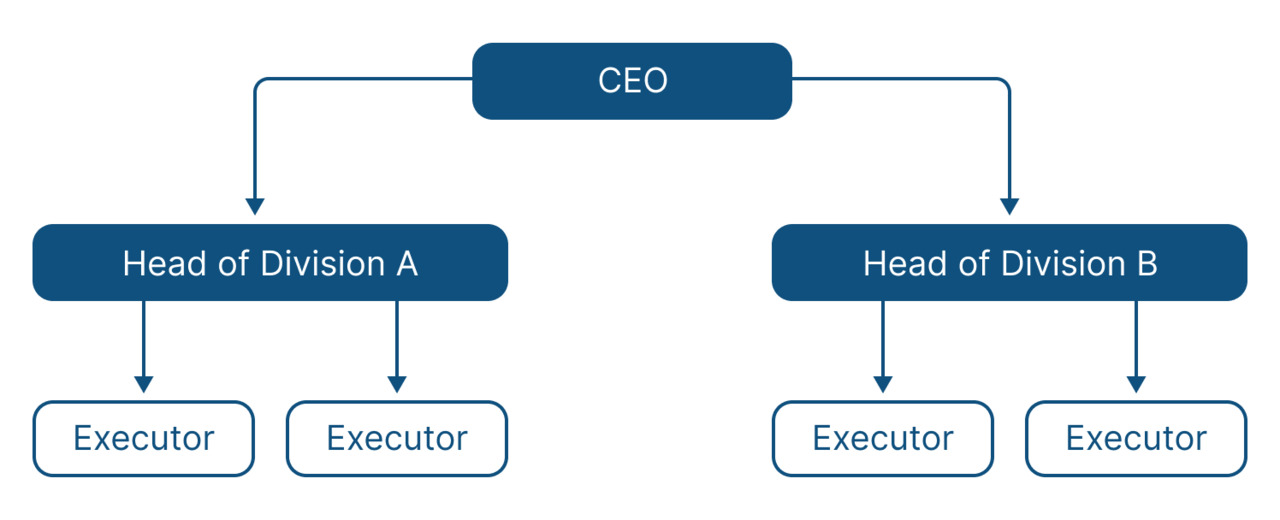
Pros:
— simplicity and speed of management decision-making;
— quick reaction to instructions and orders;
— a clear allocation of responsibilities and responsibilities;
— discipline.
Cons:
— overload of managers;
— concentration of a large amount of non-core work on managers;
— weak relationships between the performers;
— with the growth of the organization, the number of management levels increases rapidly, which reduces the flexibility of the company and the speed of response to changes.
Functional
The division of responsibilities is based on the functions performed: production, sale, marketing, accounting and tax accounting, financial management. At the end of the day, everyone takes his own direction. Optimal for small companies that work with one product, but require already more complex production organization.
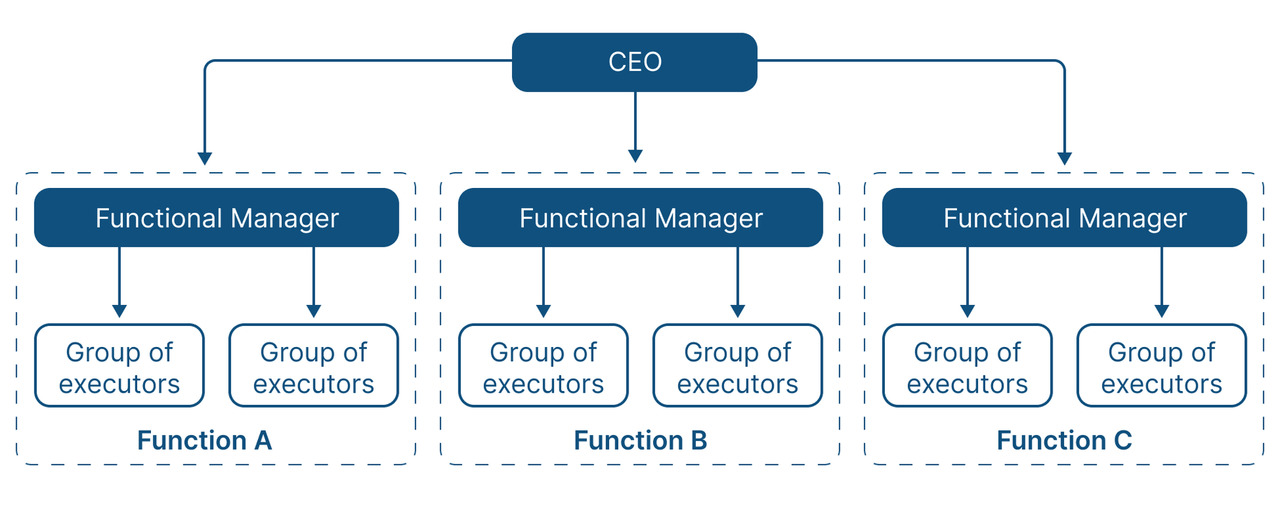
Pros:
— narrow specialization of directions — increase of productivity and quality;
— a clear allocation of responsibilities;
— exempting line managers from functions outside their competence;
— no duplication of functions (if business processes are built).
Disadvantage — the larger the company and the larger structure, the more difficult it is to organize the division and communication between the departments, while retaining the team interaction. Bureaucracy is beginning to flourish.
Linear-functional
The combination of distribution of linear and functional problems. In line management, there are production units where the manager is responsible for everything and support functions are performed by functional managers.
An example is a production hall with a technical director who is responsible for the work and discipline of the staff, the state of technology, productivity — in general, for everything. At the same time, there is a management apparatus, headquarters, where all support functions are carried out: procurement, search for contractors, travel arrangements and so on.
It is the most common among medium and large organizations, where people from a few hundred to a couple of thousand. Optimum in a stable environment: standard production processes, stable demand and external environment, without the need to implement a large number of projects and create new products.

Pros:
— narrow specialization of directions — increase of productivity and quality;
— the ease and speed of managerial decision making;
— quick reaction to instructions and orders;
— minimizing duplication of work.
Disadvantages:
— high, sometimes unjustified, administrative staff costs;
— the growth of bureaucracy when functional managers are more interested in their security than in overall success.
Divisional / Market / Grocery
Similar to the linear structure, but the divisions are structured according to the principles of product or market separation. Optimal for companies with a large number of markets and heterogeneous products. For such enterprises it is necessary to create individual basic business processes for each product / region: supply, production, marketing, sales.
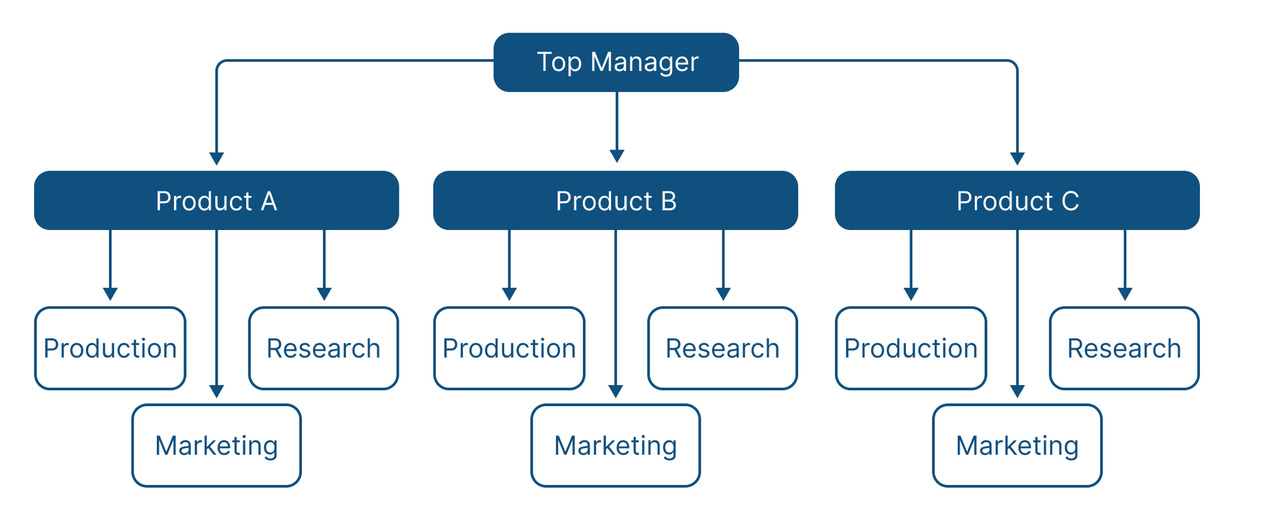
Pros:
— flexibility — individual strategies and business processes can be developed for each product / region;
— easy coordination and coordination of management decisions;
— high speed of response to emerging problems;
— high performance and management quality thanks to specialization.
Cons:
— as in previous models, there may not be a common goal, each for himself;
— unhealthy competition between structures and directions, growing political differences;
— different productivity;
— low budget efficiency.
Matrix
It is a complex model designed primarily for project implementation. A staff member may have multiple supervisors, and project and resource management is entrusted to the project manager / office.
Sometimes attempts are made to create hybrids of linear-functional and matrix models, where the implementation of projects is entrusted to functional managers. For example, an industrial safety system is being introduced and the head of the industrial safety department becomes.
Pros:
— is responsible for the implementation of a manager with high professional competence;
— the project manager can influence the situation at his own discretion, without unnecessary control (but this is rare).
Disadvantages:
— complexity in the implementation of projects and allocation of responsibilities, conflicts of interest, requires a high level of competence at the manager;
— low performance;
— duplicate functions.
I will give an example of the implementation of this approach.
Integrated corporation with central apparatus in Moscow and a large number of regional units with linear-functional structure.
The central office initiates the implementation of a complex IT system that covers a large number of business processes and requires the inclusion of both technical and financial and HR. In each regional division a responsible manager is appointed and fun starts… The manager is responsible for the whole project, but the resources and authority to manage other people’s (financial, HR) blocks are not, and the desire of others to change at will is even more so. The curator in the central apparatus is not all-powerful and is also located within the functional subdivision. In general, to implement such a project — a hell of a quest.
Matrix structures can also be divided into weak, strong and balanced.
The weak
Weak matrix structures are used when there are many projects, but they are small and not routine, not critical for the company.
In a weak matrix, the members of the project team are managed by functional managers (Chief of Industrial Safety, Repair Planning, Procurement) whose authority is limited: each is responsible for his or her direction.
There has to be a project manager who reports to management or, in this case, central office, gets his tasks. Tasks are then decomposed into smaller tasks and assigned to functional staff. But in fact, it has no powers and no resources. It is fertile ground for conflict.
It is also possible to have «forwarders». These are people in functional areas who disseminate information but have no authority — informal leaders of opinion.
As we can see, this approach is not applicable to our large-scale project. Unless we have very charismatic and strong project managers on the ground.
The strong
Differ in that the implementation of such a project may not be one, but several managers, or the manager and team, and they have much more authority. They can now not simply hand over tasks, but also give orders, require tasks and project reporting from functional managers. In addition, the project team may not be a permanent part of the functions, that is, it is possible that they will deal only with the project, plus they can search for contractors or order raw materials.
For our conditional IT system implementation project, this approach may be redundant. Although, perhaps, it will increase the chances of success, but such implementation comes out very expensive.
Balanced
In this case, the project manager is appointed from among the staff and, better, from the functional managers. Here he can set tasks and monitor their performance. However, it is likely not to be exempt from its operational tasks and to be unable to manage its own resources.
It is worth noting that this is the most difficult option to implement, as it involves the largest number of assigned roles, moreover, there may also be issues with subordination and, consequently, matrix conflicts.
Summary
We have dismantled the main types of org. structures. It would seem, choose the right, suitable for your company, and everything will be fine. Alas, it is not so. It is important to distribute functions and powers correctly, to identify a key product of the activity, to choose the people for whom this work is suitable psychologically, and also to build communication between them. That is why I always speak of a systems approach: it is impossible to implement any one tool — integration is needed.
Besides, as we can see, already at org level. The structure is related to the number and size of the projects implemented, that is, there is a close interweaving of work with the organization. structures and project management, they become inseparable.
To consolidate all practice, I propose to look at one real example with two structures of the same type, but with a completely different substance. Since the organizational structure in the book is almost impossible to display, everything will be available via QR and the link below.

Additionally, it should be remembered that with the development and organization. structure, and distribution of functions should change.
In addition, there is a trend in the world to avoid large bureaucratic structures. Why? In addition to economic factors and long transmission chains, this is a breeding ground of irresponsibility. As a result, there are a lot of people in charge, but all are formally covered up, and Ivan’s locksmith is to blame.
Here is a practical example: the repair of industrial equipment has been exceeded due to a chain of events: could not form a brigade because one of its members failed the exam because the head of the service could not form a commission for the exam, because two people on the commission were on vacation… Additionally, nobody seems to blame, but in the end, the object is worth… Until the Chief Engineer, in a terrible curse, corrects the situation in the simplest but not the most obvious way for all listed.
This case isn’t really just about an organizational structure where, under the guise of collective responsibility, the mess is going on. It is also about the corporate culture, which is based on the direct execution of rules (the culture of rules), and formed it the same chief engineer and his predecessors.
Could even in this structure avoid these problems? Of course! With proper work of managers, building of control points, informal communication, leadership qualities of this situation would not be. Additionally, here the main thesis that will go through the book — it is impossible to build an effective business system with one tool.
Main approaches to modelling and description of business processes
Introduction
In addition to organizational structures, there is another key area — business processes.
A complete list of almost all approaches to description with illustrations, display examples and videos available IT-solutions is provided by QR-code and link below.
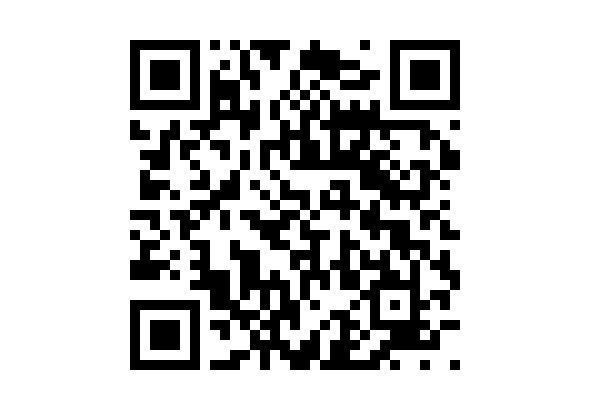
Here I will consider the most common ones, answer who they are, show what I observe in life, use it myself, and summarize — what is more important: structure or business processes?
I understand that all this may seem boring, but in practice I have learned one simple rule — there is nothing worse than arguments «it is so clear», «it is too simple». Always, when I have met such arguments, this has not boded well. These theses are harbingers of chaos and disorderly problems. So, I chose this structure: first a little bit of general theory, then practice and working principles.
Basic approaches to the description of business processes
A business process is a certain algorithm of interrelated actions of people and IT systems, which is aimed at transformation of «raw materials» into «product» or result.
For example, the business procurement process involves the following stages: requisition, sourcing, solicitation, delivery of materials, delivery to the requisitioner. But each stage is also broken down into separate business processes. Therefore, you need to understand that the description of business processes is almost infinite task, and you will need to choose the level of detail, at which you say «all, enough». The lower the level of command competence, the more detailed should be made the description. Or you need to train the team, but then you have to grow as a leader. Smart personnel will not tolerate treatment as fools.
Conventionally there are several approaches to the description of business processes:
— Value Chain Diagrams (value added chain diagram, VAD);
— SIPOC;
— Event-driven process chain (EPC);
— BPMN 2.0 (Business Process Model and Notation 2.0);
— Flow Charting (Process and Procedure notations);
— IDEF (Integrated Definition Language);
— UML (Unified Modeling Languages);
— VSM (Value Stream Mapping);
— ARIS;
— DFD.
Value Chain Diagrams (VAD)
An approach that allows you to describe at the highest level the key activities of the company and departments, show the relationships between them. Here the focus is on graphical display of business processes that create value for the client.
That is, it is a kind of «master model», which gives the whole team an understanding of how its work affects the company as a whole.
Rules of construction of VAD-model of the value-added process:
— To begin with, it is necessary to identify the key tasks of the company or division that characterize its activities.
— Their logical relationship is then constructed.
— The owner and the unit responsible for the process shall be identified and specified.
— The main documents regulating the business process are indicated.
— Additional information and resources required to complete the business process are indicated.
— Links to lower-level diagrams (VAD or EPC) are attached to each upper-level business process.
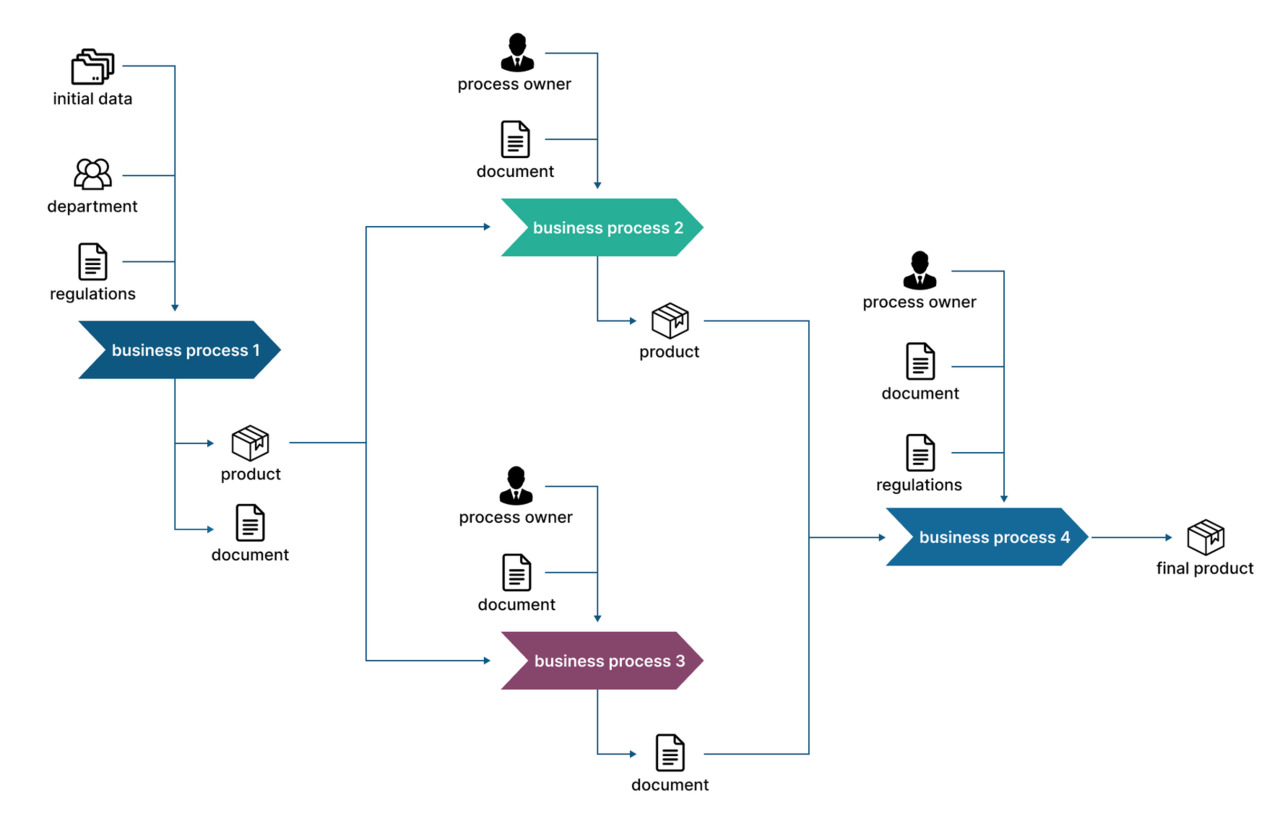
SIPOC
Approach to the description of business processes, which is a tool in lean production. The title reflects the whole essence of the approach, which focuses on five components:
— Supplier (supplier) — person or company that supply resources for the execution of the business process (production, money, materials, data);
— Input (input) — resources for business process: materials, money, production capacity, data);
— Process (process) — all those tasks that allow the result of the work to convert the raw material into the final product;
— Output (output) — products of business process activity;
— Customer (customer) — recipients of services, those who use the product of the business process.
The SIPOC business process is described from the end:
— Identify the customer of the business process;
— Describe the final product (output) that the customer needs;
— Highlight 5—7 key business process operations;
— Identify the necessary resources (input) for the business process;
— Identify the providers of these resources
The key advantage is the speed of description, the ability to identify unnecessary steps that do not create value. This approach is somewhat similar to VAD and is a top-level description. Allows to identify the most obvious losses.
Process Event Chain (EPC)
This approach describes business processes in the form of individual stages/steps of the process and events that initiate these steps, that is, the structure of the «event — function — event» is obtained. This method is well suited for standardizing business processes and analysing the flow of documents and necessary information throughout the business process.
Main elements of the description:
— An event is something that creates the need for action.
— Function is an action to get the desired result, in response to an event.
— Performers are those who perform the function, including approving, coordinating, etc.
— Resources are all that are necessary for the implementation of the function: money, information systems or individual modules, documents, operational risks.
Unlike the previous approach, where the beginning was on the left and the finish on the right, everything starts from the top and goes down.
Description algorithm:
— Determine what we have and what we want — boundary events.
— Describe intermediate events that are inside this process and what tasks need to be performed / to implement functions.
— We add all the necessary information on implementers and resources.
— Analysis of the completeness and quality of the scheme, whether it takes into account all variations and sub-processes. If necessary, make additional schemes for sub-processes. However, here I recommend always remember the rule from the first book — one scheme, one sheet or screen.
Plus, the approach — the ability to then create clear rules in the form of text or table. This notation is quite common, especially in large organizations, because on the one hand it standardizes the description and on the other it is quite flexible. For example, it is often used to configure ERP systems.
BPMN 2.0 (Business Process Model and Notation 2.0)
BPMN — today a de facto standard in the description of business processes with a wide set of graphical elements for modelling. If for ordinary users and managers this is not the most convenient approach, then for business analysts it is a mandatory tool: to describe within this approach a fairly large process on one sheet will be difficult, in addition, the approach is quite strict, However, this is more detailed and it is easier to identify local errors.
An example of the description in this notation below.

What I observe in life and apply myself
Unfortunately, in 99% of companies or no description of business processes, no top-level or even more detailed, or it is formally and made to tick, and in life everything works differently. Additionally, as long as the organization is small, 5—10 people, it is not scary. But after it begins to grow, chaos becomes more expensive pleasure.
In my life I adjust to the task, the level of maturity of the company and employees. It is mainly a hybrid of EPC and Notation Procedure (more on QR code at the beginning of a section), and sometimes a simple flowchart.
Summary 1 of the chapter and recommendations
More importantly: organizational structure or business processes described? Where to start? This is a perennial discussion. My personal opinion: as long as the company is small, it is becoming or restructuring, the selection of the business model that will give a result, you can do without business processes. If you have an organizational structure, clearly defined functions, a key product and, preferably, metrics (I do not make this a must, because I have seen isolated cases of a qualitatively developed system of key indicators), then you will not drown in chaos. People will be able to communicate and negotiate among themselves, which is a key element. I would even say that it is a useful exercise to first teach people to work together, sharing power, responsibility and resources, and then to implement process management. As a result, the work with the Org. structure will create a skeleton of the management system, including:
— ensure efficient use of resources;
— increase productivity;
— minimize the need for regulations, rules, detailed descriptions of each business process, in general, in the work with paper;
— minimize risks to the company, especially those related to dependence on individuals;
— reduce people’s congestion and turnover. Instead of one or two universal «working horses» there will be a distribution of tasks, the uncertainty that causes stress and burnout will be reduced;
— unload yourself as a leader: you do not have to often interfere with processes and understand conflicts, as the system will become transparent, everyone will understand their area of responsibility. It’ll be easier to pick up people and prepare job descriptions.
In addition, in the early stages, including the start of digitalization, your business processes will change too often, and constantly change and update them — too expensive a pleasure. Additionally, if you describe and «freeze», you lose the main advantage of the young team — its flexibility. The exception is critical processes with high risks and back-office processes, they are often stable and better dealt with initially.
However, after the initial stage is completed, it is necessary to engage in business processes. It is not necessary to fix everything and detail, but the most critical processes, where the risks are high, where problems begin to occur, should be described at least at the upper levels. Top-level approaches have the main advantage — speed and simplicity. And this will have an effect, and therefore, resources and motivation for in-depth work.
For grown-up companies there is another problem — bureaucracy. There is already a reverse approach — simplification of business processes. In general, as always, the search for a balance between chaos and entrepreneurship and order with bureaucracy.
As I said earlier, the right org is important. structure, proper distribution of authority, resources, responsibility and people, taking into account their psychology, system and personality balance. Additionally, if you listen to the classic science of Peter Drucker’s administration, you have to initially describe who you need, and then you have to choose the person for these tasks. This is the key message of his work «Effective Leader». But I have a slightly different opinion here.
This approach in a pure form is viable in an already mature company, where the requirements for candidacy are grounded, and the structure is balanced. In addition, such a company is attractive in the market due to the decent payment and the established reputation. If you are still young, you do not have a balanced system and/or you do not have a queue of applicants, then a certain flexibility is required. Yes, it is better to base on the principle of Peter Drucker, but the organizational structure needs to be adapted to the available resources and people, their psychological qualities, soft skills and competencies. That is, as usual, remember how to, but seek balance with what is.
This is basically the basic rule of life, and there is no ideal solution or methodology for either organizational structures, business processes, or project management approaches and so on. It is impossible to get rid of the psychology of people and technologies or tools to solve all problems, but to strive for an effective and autonomous system is necessary.
If you decide to approach the search for a new employee systematically: describe the functionality, requirements, its KPI, what characteristics should have, it does not mean that you will find the ideal, but it means that you are likely to find someone who will be useful to the company, will be suitable for its culture, although in some details will differ from the image of the ideal candidate.
How to build a suitable organizational structure? And how often to revise it?
I recommend the following algorithm:
— Define the goals of the company, its strategy: rapid growth, smooth, holding positions, scaling to new markets. It also determines which areas of the organization to focus on.
— Evaluate a company: what industry and its potential, what product, what technology lies at the core, and how often will have to implement projects, what markets.
— Assess available technologies and resources, including digital ones.
— Choose a structure and describe for each unit and position 4—6 key functions, target product, required competencies (professional, personal) and, where possible, available resources.
— Describe the main business processes, starting with the VAD-approach. Here you need to see the main stages of product creation, understand which of the participants in the process creates value and what.
— Assess: Do all these people and units create value? Where are the losses? What can be abandoned with digital technology or outsourced? If you only build a company, it will provide minimal costs, and if you transform, you will release resources to priorities.
Another recommendation: When goals are achieved or after the introduction and mastery of new technologies, revise your organization. structure. Or make it a rule every 6 to 12 months.
With regard to business processes, I can make the following recommendations:
— initially make a VAD-scheme throughout the company;
— prepare a process registry (first, second and third level processes, process owner, process participants);
— then take advantage of product management and system restriction theory to select priority business processes;
— it is also important to describe those business processes that are stable and are the best practice for others. Or, conversely, useful description of problematic business processes;
— does not need to describe every business process, only those tasks that are either standard or carry risks for business;
— begin to describe processes with approaches that you understand and who will use them;
— describe business processes so that they fit on one sheet A4 if you want to start the process, and in the notation BPMN if you want to analyse and optimize the process. Additionally, only after optimization do IDEF to deal with automation;
— describe the processes and prepare instructions or memos as if all the employees will leave tomorrow, and the replacement will come fools or 8-year-old children.
At the beginning of the book, I said that digital transformation should be your strategic goal, and therefore, this role should have a place in the organizational structure. Simply put, someone has to be responsible.
In general, I believe it is necessary to proceed from:
— your scale and availability of resources;
— the current level of digitalization and readiness;
— the limitations of the system (which will be discussed in the next chapter), global goals (to overcome the crisis, to ensure growth conditions, active growth) and objectives (to restore order, create new products, improve product supply).
There are many variations, and therefore, and possible structures. That is, to begin with, you need to pass a diagnosis. It is as with health: before treatment, it is better to undergo an examination and make a diagnosis, from which there will be a plan of treatment or recovery. But given that digitalization and digital transformation are strategic tasks, and the price of error may be too high, it should always be its driver.
If you are an entrepreneur or owner of a small business, it is better to find an experienced mentor who will help you to manage this direction, giving to outsource only some tasks on automation and software implementation. You can also find a team from the outside that deals with digitalization and turn-key digital transformation, with all the skills and necessary experience. The second option suits medium-sized businesses. But in any case, you have to understand automation, digitalization and digital transformation at least on a basic level.
If your business has grown from small to medium, in connection with which there are signs of chaos and lack of work with data, then you need to restore order and eliminate losses (in the chapter on thrifty production talk about this concept), remove internal restrictions, CDO 1.0 and 2.0 in data management. To do this, it is better to give the role of the leader of digitization to the operating director.
If the problem is a weak food supply, then this function should be given to the commercial director. In this case, it should be remembered that in any case to oversee this task as strategically important will be the director and/or the owner.
In any case, it is necessary to organize comprehensive training for a commercial or operational director. If digitalization is the responsibility of the Business Director, it will be commercially calibrated and aimed at increasing sales, which means that it will generate additional resources rather than processes and introduce a conditional electronic workflow just because it is necessary (by the way, the EDO can really bring huge benefits and eliminate just internal chaos and costs).
Well, if you’re a top corporate manager with resources, it’s best to have a separate division led by a CDTO (Digital Transformation Manager), which will build the methodology of the system approach and act as a centre of expertise in digital technology, processes, project management, product development. The team should necessarily include: a process specialist / business analyst (better couple), a data specialist, system analyst/architect, an IS specialist (to this we will dedicate the next book), a portfolio manager (if you train the staff, one is enough, if not, the project manager to each unit). If you put them in different units, these people will have to build horizontal links and matrix interactions. And this is longer and suitable only for mature companies, with respect in communications. If the company is less mature, it will result in an increase in the time. A weak system requires centralized control.
Key, I strongly advise against giving the digitalization and digital transformation function to the Director of Information Technology. After all, a rather limited number of IT directors can engage in process re-engineering (which is the core of transformation), approaches to project implementation, product development, has a customer focus, including to the employees of their company. For them, such concepts as UX|UI design of solutions and processes are distant.
It is necessary to pay attention to the IT departments themselves — to describe their structure and processes. Otherwise, with the increase in the number of IT tools, they will stop coping. You will either have to inflate their numbers, and they will become less organized (people will not understand who is doing what, there will be no training and commissioning processes). And/or everything will work randomly, especially technical support. And this is a direct way to discredit digitalization.
As a result, the main advantage of working with business processes and organizational structure — the opportunity to abandon expensive professionals, including IT developers. You will be able to focus on the selection of analysts (business and system) and trainees, who will grow under your company, and who will be 2—3 times cheaper than experienced experts. At the same time, it will be easier to manage them. At the same time, it will be easier to manage them, and the return from IT is higher, the cost is lower. You will also be able to build your work with data: what data is generated by the company, what is needed, who and why, and work with data is key in all digitization and digital transformation.
Chapter 2. Systems limitation theory
The second tool I want to share, and without which it is impossible to do business, is Eliyahu Goldratt’s restrictive theory.
The essence of the theory is to find bottlenecks, system constraints and eliminate them, while increasing the performance of the entire system. This approach also warns of the danger of excessive productivity of one element, i.e., at times the overall success requires reducing the productivity of individual units.
To understand the principle of this tool, consider two practical examples.
Practical examples
Example one.
You need to increase the productivity of the factory, let’s say, on the production of metal doors. You can approach this issue in two ways:
— reducing internal costs and losses by organizing lean production;
— through modernization and technical re-equipment, i.e. there is by removing technological restrictions.
Suppose the arrangements had exhausted their potential. You’ve digitized and visualized your processes, eliminated all the losses, and then you’ve measured the performance of the units, and you’ve discovered that the system’s limitations are now the paint shop.
Then you went to the production manager, and he brought you a list of things to upgrade.
According to preliminary calculations, 200 million rubles are needed for the modernization of the workshop, which will lead to an increase in productivity by 40% and a reduction in the proportion of rejects by 80%. Together, this will increase total productivity by 60%.
You then visualized the flows in production, modeled all the scenarios depending on the product line, and found the system’s limitations inside the shop. Help in this lean production (circle Tahiti Ono, elimination of losses) and mathematical modeling.
As a result, you saw that you can invest only 10 million rubles, and the productivity of the shop will increase by 35%, and the share of rejects will decrease by the same 80%. The total productivity of the enterprise will grow by 53—55%.
This is the principle of system constraint theory.
The second practical example.
A business venture where sales are more than successful. But its limitation is production capacity: production does not have time to process and release all the orders taken, and raw materials are purchased for them. As a result, we get:
— the stock of raw materials and semi-finished products is being overloaded, and storage capacity needs to be increased. This increases the cost of rent or new construction, requires additional staff, also increases the risk of damage to raw materials;
— the raw material begins to be stored longer in stock, which leads to an increase in frozen working capital and future losses. Some of it will go into marriage.
All these are losses in terms of economical production. Additionally, in the language of economists, it is frozen circulating funds, which is also very unpleasant. In addition, there are other effects:
— cancellations of orders, which are reputational losses, risks of penalties, plus raw materials need to be sent to recycling or «perpetual storage» due to the inability to apply it to other orders;
— deterioration of the KPI sales department and managers, which leads to conflicts between departments;
— will start to appear «urgent» and important orders, which is already interference in the production cycle and even more reduced productivity with an avalanche effect;
— increased pressure from owners on production, a further deterioration of the climate and an increase in staff turnover.
As you can see, a huge number of losses are generated, which we will talk about in the next chapter. They lead to a «perfect storm» and crisis.
This example is taken from real life. The company changed 8 managers and 90% of the production staff for the year, there were risks of penalties of 20 million rubles. And the limitation here was in the managers. Yes, the restrictions are not always technological, we will consider a detailed list below.
As a result, it was necessary to reduce the productivity of the sales department, to restructure production processes, and then to develop commerce again.
In terms of digitalization, the system constraint theory will help us to understand where the digit is originally implemented. And this will allow you to quickly feel the effect for a little money, which in turn will remove resistance from the team and will increase the amount of finance available for further changes.
In transforming and increasing efficiency, it is not only changes and technologies that are important, but also the point of focus. Additionally, eventually, it will increase net profits.
If we go back to the instrument, there are five so-called «focus stages» in the constraint theory.
5 steps — the essence of the whole tool
Step 1 — Finding a constraint.
Constraint is a weak link (resource, people, technology, materials) that hampers the effectiveness of the entire system. It comes in two types: internal and external. Example of the first — the capacity of the equipment, the competence of employees. External factors are the market, its competitiveness, saturation, capacitance, seasonality, purchasing power.
At this stage we identify key constraints. Tools that can help: brainstorming, TRIZ, simulation and flowcharts, mental maps.
Step 2 — decide how to make the most of the limitation.
To demonstrate this approach, let us take the example above of capacity constraints.
How can productivity be increased without large investments?
First, we introduced operational planning a day in advance. From the morning everyone knew what to produce and in what order. Secondly, we began to organize the importation of raw materials for the day shift in advance, as a result of which people immediately began work after the morning meeting. Third, we switched from 5/2 to 8 hours for 2/2 to 12 hours. This alone increased the number of working hours from 40 to 84, that is, more than doubled. We add a 2.5-fold increase in productivity due to loading planning (machine time increased from 30 to 70%) and we get a multiple increase in productivity. Thanks to this, the department has started to fulfill all past orders plus all major from network customers (IKEA, Leroy, Castorama).
Step 3 — Manages the system with limitation.
Now we begin to develop sales, understanding the maximum productivity of our workshop. In addition, we must develop a maintenance policy to avoid downtime and work with staff motivation.
Step 4 — extend the restriction.
We’re moving on to performance enhancement. For example, we introduce the principles of lean production, optimizing including workshop and warehouse logistics, so that there was not a large number of partially executed orders, and by the beginning of the production cycle all the raw materials were in stock. After that it is possible to plan the modernization of the equipment of the workshop to further mechanize all operations and increase productivity.
Step 5 — return to step one.
Returning to the beginning of the algorithm means finding a new constraint — the most pressing problem in the new conditions. For example, the need to modernize other producers or to plan the supply of raw materials, increase the value of the supply and the value of the goods. Thus begins a new stage of business improvement.
Where did our work on productivity lead? If at the beginning of the project we had 300—400 m2 of raw material warehouse, and the finished products were shipped from the workshop, then after all changes, we had an empty stock of raw materials, everything was started for production immediately after unloading, and the finished products were shipped from a separate warehouse with 150—200 m2. Here productivity was already limited to the supply of raw materials.
Key tools
— Method «drum — buffer — rope»
«Drum» — internal limitation, for example, limits of how much an enterprise can produce.
«Buffer» — before limitation there should be some buffer of materials stock, protecting the limit from downtime.
«Rope» — materials should be put into production only when the reserves before restriction have reached a certain minimum, not earlier, so as not to overload production (one of the principles of lean production).
— Critical chain method
Its essence is that it is necessary to reduce multitasking, get rid of the student syndrome and take into account the law of Parkinson’s.
Our brains can’t do multitasking. It’s a myth. In fact, what it does is people start switching from problem to problem, not getting any through, abandoning them, and then people have to spend their time getting into the game. This takes, on average, at least 20 minutes. Therefore, limiting the number of tasks to three, can increase human performance to 50%.
Student syndrome is the habit of many people of postponing and starting a last-minute task.
— Thought Processes
Here we use modelling and analytical schemes:
The tree of current reality is the identification of causal relationships between undesirable phenomena and the root cause of most of these phenomena.
The Conflict Resolution Diagram is the removal of contradictions and hidden conflicts in a system that often cause chronic problems.
The future reality tree is a schematic showing how the system should work with all revisions.
Transition tree — identifying and addressing possible barriers to change.
The Change Plan is an action plan with instructions for implementers.
This approach is described in artistic form in the book «Goal-2. It’s not about luck». A more formal academic language is in the book by W. Detmer «Goldratt’s Restriction Theory». You can find them by QR-code and link at the end of the chapter.
There are also eight rules in theory to follow.
— Clarity and unambiguous understanding of all terms and statements used.
— Every statement has a complete thought.
— All the causes identified cause these effects, that is, the causal link is not broken.
— The reason given is sufficient to trigger the said effect.
— Possible alternatives have been tested, and it is this reason that leads to the effect.
— Cause and effect are not confused.
— The presence of side effects in the identified cause that also point to it.
— Lack of tautology.
Constraint type
Goldratt identified the following types of restrictions:
— Physical Limitations
Limitations due to equipment performance, lack of materials, space, people.
— Political Restrictions
These and informal restrictions in the style of «we work here so» or «we have it so usual», and formal regulations and procedures. For example, the need to write letters through the first persons with approvals for 2—4 weeks of each letter instead of direct communication between the performers.
— Paradigm Constraints
These are well-established habits in work and ways of thinking, decision-making. They limit the possibilities for finding solutions and better working methods. It’s more about psychological restraints on thinking, including leaders.
Additionally, in many projects, it is the limitations in the personal effectiveness of the manager, the incompleteness of his knowledge and resources: the ability to critically approach priorities, the skills of setting objectives, concentration, attention, time, etc. eventually become a constraint on the productivity of their divisions.
— Market Restrictions
This is a situation where your capabilities and capacities are higher than market demand. This happens when you grow systematically and scale successfully and capture the entire market.
— Typical errors
Stopping the process of improvement after the next stage
You should avoid situations when after the removal of the next restriction you will say «stop, stop». Search and removal of restrictions is a continuous cycle. Restrictions will always stop. This is not a one-time project, but a permanent feature. This rule is laid down also in lean production and Kaizen philosophy (we will talk about them in the next chapter).
If you have the feeling that everything is enough, then this is the first signal of stopping development. Inertia will be fine for a while, and then degradation will begin.
— Narrow focus
Many managers focus on measurable metrics of major economic activity. And productivity is excellent, and revenue is rising, and in a good case, even profits continue to rise. As a result, they calm down, forget about building the system, work with the team and its motivation, the need to adapt to new conditions after growth. As a result, they see the problem even when all this is reflected in the figures, and begin to sound the alarm, when already half the company in chaos and extinguish the fire expensive and ineffective. You always need a system view and «helicopter vision» on work processes and product: the more areas of restrictions monitor, the better, and for this it is useful to know what are the limitations.
Chapter Summary 2
System constraint theory is an independent management tool. However, its use in digitalization projects allows you to set priorities and determine where to run and what to do first in order to obtain resources for further development. Combined with other instruments, it has a synergistic effect.
Is it necessary to use all the complex tools described above: building trees of current reality, future and so on? No. If you can look at business as a system, understand all the relationships, build a control system, it can be avoided, you will know your bottlenecks and where to direct resources as a priority. But gradually, the better your situation, the more unobvious will be the restrictions, and then you will have to dive into the work with diagrams.
At the same time, as practice shows, the main limitations are buried in the thinking of leaders. Remember the second practical example where changes were made, including changes to the operating modes of production? What do you think happened after I left and the end of crisis management? I think you’ve guessed. Managers decided that everything is fine, you can again fully include sales, without taking into account production capacity and adding «urgent orders» to the daily schedule, neglecting tactical and operational planning. In the end, three months later, everything came back: the delay started to grow, people began to complain. That is why the same Toyota warns in its thrifty production that one cannot focus on formal tools, one needs complex work, including with people. And I totally agree with that.
A detailed article with illustrations and videos is available on QR code and link below.
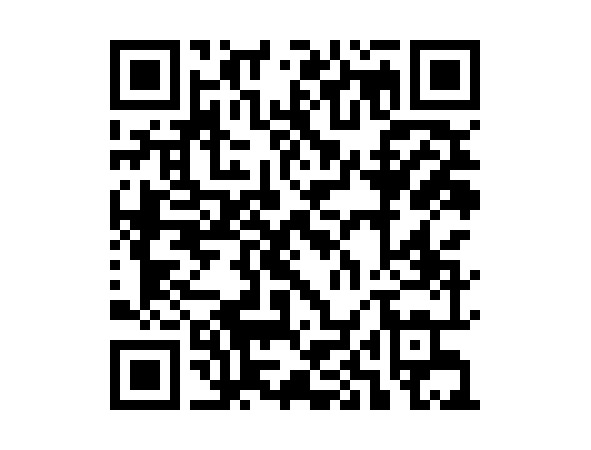
Chapter 3. Lean Production and 6 Sigma
Now let’s talk about lean manufacturing, a tool that allows you to build tactics and understand how to make the most of digital technology.
Lean production (lean manufacturing) is a management approach based on a constant commitment to excellence and loss management. Developed this Toyota approach more than 40 years ago, and it was one of the keys to its success and global leadership. In the 1990s, frugal production saved Porsche from bankruptcy, and now it lies at the heart of the production system of any global corporation.
In recent decades the essence of the concept was superimposed on «6 sigma» and it resulted «lean+6 sigma».
For a deeper dive, I recommend reading «Dao Toyota. 14 principles of management of the world’s leading company» Jeffrey Licker. All necessary links you will find in the article by QR-code.
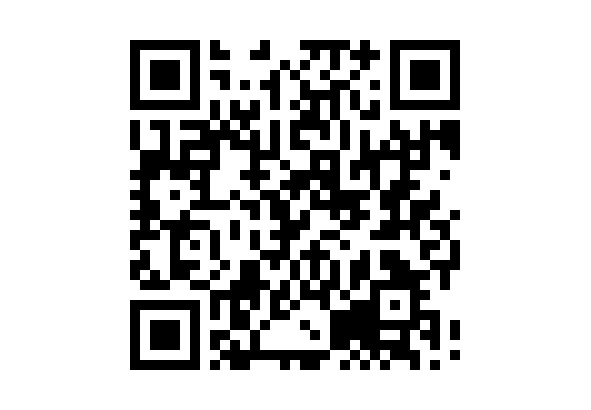
Before we get to the theory, I’ll give you three practical examples of how this tool can be used in digitalization.
Example 1
Toyota will use video cameras and neural networks to analyze employee performance and identify losses, continuously optimizing work operations.
Example 2
By standardizing the report form and automating the calculations of the required coefficients, the cost of the report in one company decreased from 3000 to 300 rubles. How? By eliminating the losses for over-processing.
Example 3
Back in the first book, I was talking about a system for evaluating knowledge. With the understanding of the principles of lean production a week after the use of the system there were recommendations to optimize its work to reduce labor costs by 70—80%! And this is an annual savings of up to 500 thousand rubles, because you no longer need a separate person who is engaged in only one system. Additionally, that’s often how big corporate IT solutions work. For example, in another case it was also necessary to hire an individual to give him a job in 1C, otherwise the production manager and the master could only do that wiring. That is why it is essential in automation, digitalization (analysis of the difference between these concepts is in the first book) and business process optimization to actively use thrifty production.
Now that you understand what this is all about, let’s go deeper and look at the key tools.
4 principles
Thrift production is based on four principles.
1. Determine the cost of a specific product to the consumer
In general, Japanese people love a value-oriented approach in both projects and work. Customer satisfaction with them almost turns into a cult. This is also reflected in the P2M project management standard.
Additionally, in part, that was one of the keys to their success, despite resource constraints after the Second World War. They simply cannot be wasteful because the price of error is too high. Now, under strict sanctions, for us their path and philosophy can become a kind of cheat sheet.
This approach is more than relevant in digital projects, including domestic ones.
It is always necessary to remember who the consumer is (intermediate, finite), in what value for him. Additionally, the most important benchmark in digital projects — what losses for people can we eliminate? We will talk about what is loss through the section.
Without it, we risk introducing changes and systems that no one wants to use, and they become just expensive toys.
2. Determine the value creation flow for this product (from raw material to finished product, from order to delivery, from concept to production)
Here you need to know the whole production chain. For this there are a number of tools. In the modelling of business processes there are the designations VAD, SIPOC. Product management includes CJM (client path map) and CX (user experience). We will also talk about these tools later.
This principle allows you to understand where you have problems, where you kill the client’s desire to cooperate, where you spend resources (time and money) in vain.
Well, what is the point of introducing robotics into production if the customer has to wait a week to confirm the order and answer 100 additional questions, while the production itself takes 1—2 days?
3. Ensure continuous flow of product value creation
This is where the work begins with the processes and the elimination of all expectations, superfluous agreements.
4. Strive for excellence
Here we talk about the fact that it is impossible to once optimize everything / automate / digitize and finish. We need to come back and improve our processes and services time and time again. People, conditions, technologies, and therefore, processes need to change.
This is at the heart of, for example, Kaizen, where people on the ground themselves eliminate all unnecessary actions, improve their working conditions.
14 DAO
14 Tao Toyota — the basic «commandments» of Toyota production system and thrifty production. It’s kind of like the 10 commandments from the Bible that allow you to realize the key principles.
DAO is divided into four sections:
— Long-term perspective philosophy;
— The right process gives the right results;
— Add value to the organization by developing your employees and partners;
— Permanent solution of fundamental problems stimulates continuous learning.
Section I. Philosophy of the long term.
Principle 1. Make management decisions from a long-term perspective, even if this is detrimental to short-term financial objectives.
It’s about focusing on long-term development, not operational performance. Additionally, unfortunately, it’s the one that’s most often ignored because it’s a psychological trap.
What do owners or shareholders usually want from top management? Right, beautiful revenue figures, operating margins, EBITDA, profitability.
As a result, all development projects, as a rule, are an attempt to sit on two chairs, to develop something, to rebuild, but not to hesitate at the moment. There’s nothing wrong with that, but, alas, it rarely works. Of course, if you move systematically and progressively, then it will be, but if you have already entered a crisis or have grown up by yourself, then this approach is unlikely to work.
Here it is important to remember the main postulate of lean production: your main task, as a person, as an employee, as a company — to create value for the consumer, society and economy. In evaluating any work, one should focus on whether it solves this problem.
Section II. The right process produces the right results.
Principle 2. A continuous flow process helps to identify problems.
Its essence is to organize the work and production process with minimal losses, stocks and unfinished production. This approach, combined with well-functioning communication, allows problems to be identified at an early stage before they become a danger or crisis. In my practice, this is generally the main rule, including in the implementation of projects — collect feedback and identify problems as early as possible.
Principle 3. Use the pull system to avoid overproduction.
Are you familiar with the situation where you are being squeezed into the work of another unit? I often see the principle when different units work on their own. As a result, there is stocking of raw materials warehouses or folders with incoming service / letters / tasks.
This is the most common problem for department heads in dealing with subordinates. Many such leaders, in fact, are «transferees» — they only throw tasks over to the executive. The employee accumulates 40—50 tasks, he tries to do everything, jumps from task to task, and in the end does nothing. Additionally, as practice shows, if you limit the number of work tasks to three, productivity rises to 50%. Firstly, a person does not jump from one task to another (the process of immersing the brain in the problem takes 20—40 minutes), secondly, he has at least some diversity and variability, this protects the psyche, and allows you not to hang on to one problem.
We need to get the domestic consumer who takes your job to get what they need at the right time and in the right amount. This is the basis of the tool «Exactly in time» — new products or tasks should come only as the previous. Additionally, here Kanban boards will help a lot. About them too, a little lower.
In general, it is necessary to minimize the unfinished production (current and for offices).
Principle 4. Distribute work evenly (heizunka): work like a turtle, not a hare.
Familiar is the situation of heroism and proverbs «sometimes empty, sometimes densely»? In Japanese philosophy it is called Mura. Additionally, one of the tasks of thrifty production is to make the load evenly, without talking at the end of the month and endless heroics. And the modern planning systems, including ERP, MES and APS, that we talked about in the first book, will help. Well, so are Kanban boards if we learn to look at the process and optimize it all the time.
Principle 5. Stop production to solve problems with part of the production culture, if so required by quality.
Why were so valued, and are Toyota cars appreciated? Right, for quality. If we want to work with clients who have money, we need to ensure quality.
Quality for the consumer determines your value proposition. Additionally, that’s where the smart machine with machine vision comes in, which is to watch the product and the process and see if everything works according to the technical process. You need a visual system that immediately notifies the leader of the problem. Therefore, in my projects, I make extensive use of color tags in task cards. For example, the green label means «Everything according to the plan», blue — coordination or waiting for information, red — «There is a problem, need help». Digital tools here in general give unlimited flexibility, the main thing — the leader daily to do a review and if problems arise, to turn on and eliminate the reasons.
If we are talking about production, the tool Dzidok (equipment with machine vision or complex automation) — the foundation for «embedding» quality.
As a result, the approach by stopping or slowing down the process and getting the required quality «from the first time» will increase the productivity of processes in the future: you will simply eliminate the causes of problems and deviations.
Principle 6. Standard objectives are the basis for continuous improvement and delegation of authority to staff.
Every time I hear the thesis «we do not have standard tasks», as a rule, it means that the team simply do not know or do not want to structure the work.
Stable and reproducible working methods — the key to process management. Additionally, his task is to create a more predictable result, improve the coherence of work, and make the output more uniform. It’s the basis of flow and pull.
Yes, if you have a very young company, then for a while it will be irrelevant, you need to run the whole system, give a result, but in the end there is nothing without it. Endless creativity always leads to crisis.
Knowledge should be captured, for example, by reviewing projects, identifying and standardizing best approaches and methods. At the same time, it is necessary to encourage the improvement of these standards. In general, continuous improvement — the main creed of thrifty production. But to improve something, it must first be described and fixed. Otherwise, there will be chaos with all the consequences. Additionally, this is also more than relevant for IT. Creative guys do not like to standardize their work, but alas, it is necessary through «I do not want».
Principle 7. Use visual control so no problem goes unnoticed.
This principle is actually part of the 5th principle. As mentioned, I use color labels. But it requires discipline, and it comes from a supervisor.
Where possible, reports should be reduced to one page, even if they were critical financial decisions. There is even an «A3 Report» tool for this.
Principle 8. Use only reliable, proven technology.
Technology should help people, not replace them. If we are talking about digitization and automation, it is often better to first do the whole process manually, and then implement the digit and automate.
First, you will see the most problematic places; secondly, avoid the illusion that everything can be automated. In addition, new technologies are often unreliable and difficult to standardize, threatening the flow. The same artificial intelligence, despite all its development, still admits sometimes quite stupid mistakes.
Therefore, instead of unverified technology, it is better to use a known, well-established process. At the same time, it is necessary to encourage the study of new technologies and ways. After all, everything worked out once was new. Additionally, it is necessary to quickly implement proven technologies that have been tested and make the flow better.
Help with this can be the selection of digital technologies and solutions taking into account TRL (ISO 16290:2013). The TRL is how mature the technology we want to introduce is. Therefore, the technology has 9 levels of readiness:
TRL 1: The basic principles of technology have been studied and published;
TRL 2: The concept of technology and its application is formulated;
TRL 3: Critical functions or characteristics are validated analytically and experimentally;
TRL 4: Component or layout tested under laboratory conditions;
TRL 5: Component or layout tested in conditions close to real;
TRL 6: System/subsystem or prototype model demonstrated in near real conditions;
TRL 7: Prototype system demonstrated in operation;
TRL 8: The real system is completed and qualified during tests and demonstration;
TRL 9: The real system is confirmed by a successful operation (goal achievement).
Accordingly, the more critical the impact of new technology, including digital technology, on the final product, and the higher the reliability requirements of the product, the higher the maturity level should be.
Section III. Add value to the organization by developing your employees and partners.
Principle 9. Educate leaders who know their business thoroughly, profess the company philosophy and can teach others this.
It is better to educate your leaders than to buy them outside the company. First, it is one of the key rules of motivation. When you constantly hire outsiders, you discourage your people. They begin to lose faith in the future. As a result, they focus on their goals and do not have to expect their full contribution. Second, leaders who know their business by default have high expert power and know all the pitfalls of your activities. Additionally, digitalization and automation are all about that.
Train staff in the basics of lean manufacturing, design management, digitalization, and collect feedback from the beginning.
In addition, a leader should not only perform his tasks and have the skills of communicating with people, he should also profess the philosophy of the company and set a personal example of attitude to the case.
Principle 10. Educate exceptional people and form teams that profess the company philosophy.
Principle 11. Respect your partners and suppliers, make them difficult and help them improve.
You can be as digital as you want, but if your partners live in paper, the effect will be limited. Here, as in systems constraint theory, chain strength is determined by the weakest link.
It is necessary to create conditions for partners to grow and help them to demonstrate their high efficiency.
Section IV. Permanent solution of fundamental problems stimulates continuous learning.
Principle 12. To understand the situation, you need to see everything with your own eyes (genti genbutsu).
How often have I seen stories where TOPs trusted their managers and reports on the computer? Here is a practical example. The founder of the company was from the production. Weekly he went to the production. And in the end, people understood that their work was important, motivated, and he had reliable information.
But his successor had a classical management education. He formed a team of managers, a system of reports. But what do employees want? To keep them safe and stable. That’s normal. However, with each step, from each leader the information becomes more distorted, and as a result, a distorted view of the situation is formed at the very top, which means that decisions are made based on the erroneous opinion. This is, for example, one of the main problems of public administration.
If this rule is combined with high-quality, automated data collection, transparent analytics, this problem can be avoided.
As a result, solving problems and improving processes, you need to see what is happening and personally check the data, rather than theorize, listening to other people or looking at the computer monitor. Thinking and reasoning must be based on data that are verified and sure. Even company executives and business executives must see the problem for themselves, only then will the understanding of the situation be genuine, not superficial.
Principle 13. Take your decision slowly, on the basis of consensus, weighing all possible options; when implementing it, do not delay (nemavasi).
It can also be called «think slowly, decide quickly». One of the basics of management is the need to evaluate alternatives. Making decisions based on one opinion is too dangerous and risky. If this is sometimes the only development option for young companies, the further, the more often it is necessary to use consensus, and this requires the development of the issue and several people with different opinions and psychotypes. On this, among other things, the concept of Adizes is based — one person cannot combine all the necessary competencies, you need a versatile team. To that end, it was necessary to learn to discuss views openly and to overcome conflicts.
As a result, one cannot make a clear decision on the way forward without weighing all the alternatives. In this case, there are less risks and the desire to go back and redo. And when a decision has already been made, you need to act. For example, when Toyota was developing her Prius, she worked very hard on possible variations of the hybrid approach. However, by assessing possible alternatives, they focused on one option and promoted it only, it became the de facto standard worldwide.
Nemavashi is a process of joint discussion of problems and potential solutions in which everyone participates. His job is to gather all the ideas and develop a consensus on where to go next. While such a process is time-consuming, it helps to broaden the search for solutions and to prepare the ground for rapid implementation.
Principle 14. Become a learning entity through tireless introspection (Hansei) and continuous improvement (Kaizen).
Do you think it’s possible to optimize everything? Right, in the beginning, we said that goals, objectives, technologies, products can change, and that means we need to constantly improve.
What are the approaches? You can hire consulting agencies, you can initiate regular modernization and restructuring. But with this approach, people will pretty quickly become disappointed in all this, and a culture of inert to any changes will begin to form: people will have in mind the idea that it will pass.
The Japanese prefer to follow the path of constant development in small steps, initiating changes from the performers. Additionally, for example, in digitalization — you can initiate a giant program of digital transformation, invest huge resources, and the output does not get effect.
It is better to start with the small stages of digitalization, and then, when the competencies and the conscious understanding of the need for global digitalization are formed, begin to implement global systems.
In the first book, I already gave examples of both cases: a failed implementation experience at once A total and expensive asset management system and a successful experience of using free Google tools to organize production. It’s not necessarily the right path, but I’m a proponent of that evolution.
To realize this principle, it is necessary to:
— once the process has stabilized, use tools for continuous improvement;
— create such a process that almost does not require reserves. This will immediately identify the loss of time and resources and do not start the «disease». When losses are obvious to all, they can be eliminated through continuous improvement (Kaizen);
— collect and preserve company knowledge, prevent staff turnover (i.e., understand the nature of motivation), monitor the progressive promotion of employees and preserve the accumulated experience;
— at the completion of projects, including implementation, carry out gap analysis (hansey) and openly talk about them. Following the analysis — implement changes in business processes;
— standardize the best techniques and techniques instead of inventing a wheel every time a manager changes, that is, describing business processes.
Muda, Mura, Muri and Loss Types
Mud, moody, moody are strange words, aren’t they? The essence is simple.
Let’s look at these basic concepts.
Muda is two kinds of loss:
1. Actions that do not create value but are unavoidable. For example, transportation, paperwork — it is impossible to remove them from the process, but it is necessary to strive to reduce, say, automation of preparation of mandatory reporting. In my experience, with the help of ordinary Exel, I was able to reduce the labor cost of a mandatory and unnecessary report from 8 hours per month to 30 minutes.
2. Actions that do not create value at all and should be excluded from the process completely. For example, waiting, stocks, marriage, etc.
Mura is uneven. If demand is uneven, queues are formed, execution time increases. Additional materials and supplies are required to meet peak demand. Working in emergency mode tires people and reduces their efficiency and quality of work.
All this also generates losses — marriage, waiting, excess supplies, the need to redo.
Moody is an overload of people or equipment.
We make machines or people work to the limit. Overloading people threatens their safety and causes quality problems. Overloading equipment leads to accidents and defects, which in the end also leads to losses.
These three «M» represent a single system.
Often the root of the problems — «Mura», as unevenness leads to overload «Muri», which in turn causes many other losses («Muda»).

Let me remind you that the goal of digitalization, automation and transformation is to reduce losses, mainly in working with information. Additionally, before we initiate any project, we need to understand what losses we want to eliminate.
1. Overproduction
The most common problem, which is the cause of most others. Remember the example in systems restriction theory where the sales department sold more than it could produce? Or when we make five copies of documents, when you only need one? All this is overproduction. This leads to overburdening of units, and high stocks of unfinished production or finished products in warehouses, which also increases the number of rejects.
Reasons — large batches production and unexplored demand, long retraining / restructuring.
Planning systems and deep market intelligence through big data collection can help.
2. Waiting
This is all the time during which people or equipment expect resources, technological operation, data, unnecessary coordination. The e-workflow projects are also designed to address these losses. It is only in such projects often forget to do rewrite processes, and then the electronic workflow begins to complicate the life of employees.
The reasons for the occurrence — a violation in the logistics system. For example, the boss left, and documents can only be signed manually. Or equipment failure, lack of guidance from management, lack of planning.
3. Inventories
Many buyers like to buy large batches to get a discount, even if they do not need so much material yet. Excessive stockpiles freeze money in themselves, plus all this must be stored somewhere, large warehouses are required. In addition, in the warehouse may be defective raw materials. In this type of losses hide the problems of production planning and uneven processes.
The reasons for the appearance — uneven production and poorly established relations with suppliers of materials, do not take into account the demand for products or raw materials.
Example: storage of large quantities of materials needed for production during six months, excluding warehouse maintenance costs, or production of New Year’s goods without seasonal demand.
4. Excess transport
Moving materials or goods between units that do not add value to the final product or service. This leads to both idle / waiting equipment, and unnecessary marriage.
Causes of occurrence — irrational use of production / office space, unnecessary intermediate storage areas, inconvenient equipment placement, non-optimized business processes.
Example: Location of the spare parts warehouse and production at a greater distance from each other.
5. Excessive displacement of people
Unnecessary staff movements or chaotic organization of workplaces. This loss is often combined with the previous, especially in the office. Therefore, here’s an example. The organization has an electronic workflow system, but people still need to print and archive every application manually. As a result, unnecessary movement of documents and people. If we are talking about production, then while a person is walking on the floor, he can damage other products.
The reasons for the emergence — irrational organization of the work space, lack of work standards, lack of visualization, violation of work discipline.
Example: search for the necessary tool for the operation of the entire site, the lack of knowledge of the staff of the areas of responsibility and walking, the determination of who should perform a particular operation, the lack of visual standards that facilitate the search for necessary tools and materials.
For example, a business process system, big data sensors and geolocation sensors for moving people within business processes will help.
6. Marriage
Marriage is dangerous because it is not only the disposal of raw materials and working time of machines and people in the junk, but also the reputation of customers.
The reasons for the appearance — lack of control at different stages of the production process, lack of built-in system «Protection against Fool» (Bye-yoke), lack of qualification of people or equipment problems.
Back to digitalization, the most common solution here is machine vision systems that analyze process and product.
7. Overservice
It means all those actions when we try to do better than the consumer needs.
The reasons for this are an unknown demand or a lack of incoming information.
If we go back to project and product management statistics, only 16% of the products are completely successful. Why?
One of the factors is the excessive number of possibilities in products. Only 20% of the built-in functionality is in demand regularly, 30% — occasionally, and 50% — almost never. To be even more visible, let’s remember modern applications, for example, banking. What do you really use? Additionally, did it become more convenient to use your banking application in comparison with what was five years ago? Personally, I do not. Micro-service solutions are becoming more functional, but less convenient and demanded. But their development costs money.
To simplify the example, remember the remote for the TV with a set of additional features that the consumer does not need.
8. Untapped human potential
The final loss type, according to Toyota, is unused or unrealized human potential. As the name suggests, this is the exclusion of the personal qualities, knowledge, skills and skills of the employee from the work performed by him. Unrealized human resource losses most often occur when the staff member is expected to perform exceptional routine operations, the manager does not listen to subordinates, and any activity is strictly regulated by internal standards, rules or duties.
Additionally, as practice shows, this is one of the most common phenomena. At the beginning of the book, I said that one of the limitations is the thinking of the manager, and top managers are usually bright and authoritarian entrepreneurs who love micromanagement and do not trust the regular staff, are not ready to hear different opinions. Although sometimes it is skilfully masked. In the end, we get this kind of loss. And if the head is also in a large company with a bureaucratic structure and culture, generally trouble.
The causes are an inefficient system of motivation, high competition among staff, excessive control by management, lack of motivation or even punishment for showing initiative.
It is also common for an employee to perform non-core tasks, work for himself, for a colleague and for Ivan.
All these losses are relevant for any working system, both production and office. Including when implementing digital tools. Additionally, digitalization automation is about reducing the amount of routine work that people do.
Also below is a table with examples of losses for production, office and IT.
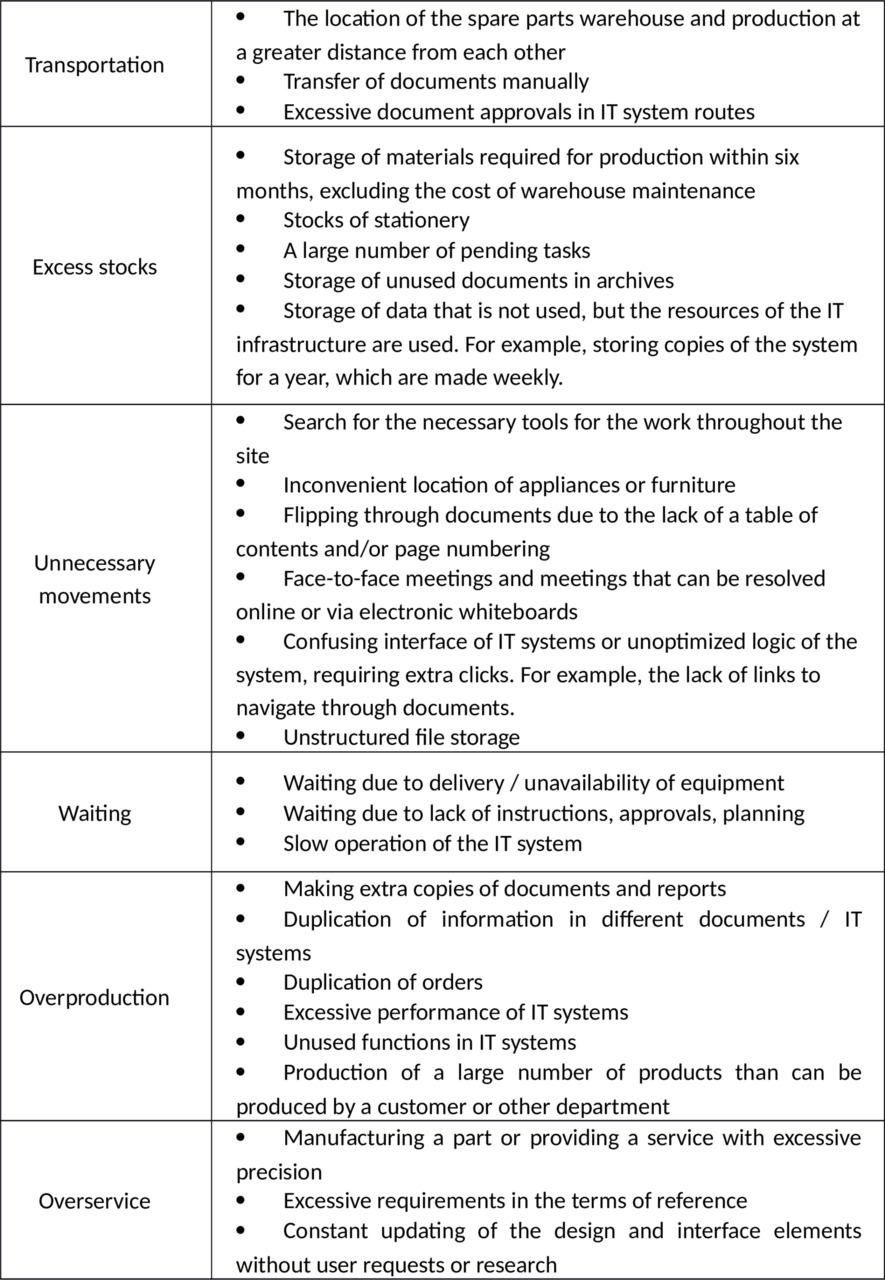
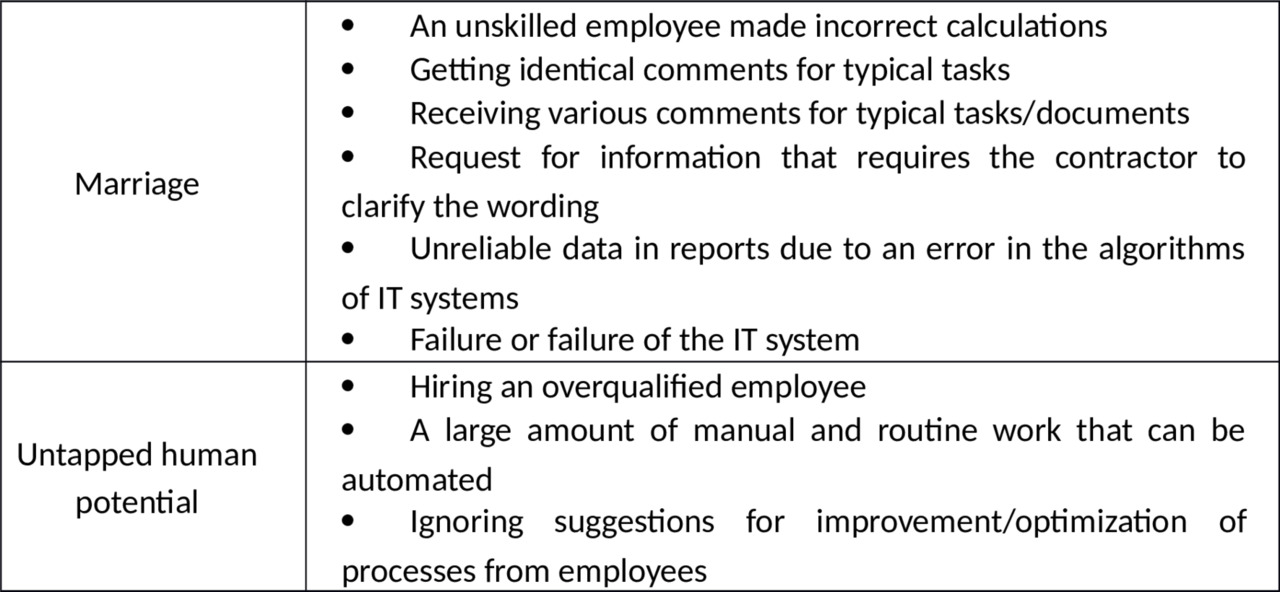
Key tools
Kaizen
Kaizen is a Japanese philosophy that focuses on continuous process improvement in small steps. The point is, the people on the ground know best what can be done. This instrument was also in the USSR, but was called the system of rationalization proposals.
For this to work, it is necessary:
constantly collect feedback and implement changes, and if they are not applicable, you need to explain to the initiator what is wrong;
people need to be trained to direct not just desires, but rational sentences, plus this will not waste time on long conversations.
This not only improves processes but also motivates employees.
In my practice, the best initiatives (the least costly and most effective) came from ordinary employees.
Examples:
1. During the production, there may be a defect or not the entire order can be made (did not have time, the components did not arrive). As a result, the packers explain the details to the head of production, and he — the planning and sales department.
The solution from the packers — put the number of each part in the drawing itself. Implementation in 1C — a couple of days.
Outcome:
planners simply give a report and drawings
the planner immediately knows what to reload, and says when the missing item comes;
the sales department clearly understands when the order is ready.
2. Feedback from operators.
Having changed the location of consumables, it was possible to reduce the time for re-ordering between orders by 50%: it was just not necessary to go to the other end of the workshop, along the way and hitting other orders.
Do you think the combination of such an approach and digital tools will have more effect than buying expensive control systems, but with chaos in normal work?
For digitalization it is generally a «magic pill». Once people accept that they can change the workflow and acquire the necessary competencies, they themselves will begin to simplify their work, including automating and repartitioning processes. The main thing is not to «encourage» them even more routine.
Well, not all employees, but 10—15% of active innovators are able to turn everything around. It is them that should be highlighted and trained system approach.
If we look at the experience of Japanese companies, then in each production workshop there is a tablet where each employee can leave a proposal.
Kanban system
«Kanban» in Japanese means «sign», «signal» or «card». Initially it is a tool with cards to request raw materials in the production shop.
These are now IT solutions for the organization of work. Their essence is creation of «pulling system», when work is taken only after completion of the previous, as well as visualization of the work process, prevention of overloading of people or units, identification of problems at an early stage and improvement of the process. We will look at this tool in more detail in the chapter on project management, as it is one of the main ones in flexible approaches.
7 Practical Problem-Solving Steps
In lean production there is a tool «7 steps of practical solution of problems».
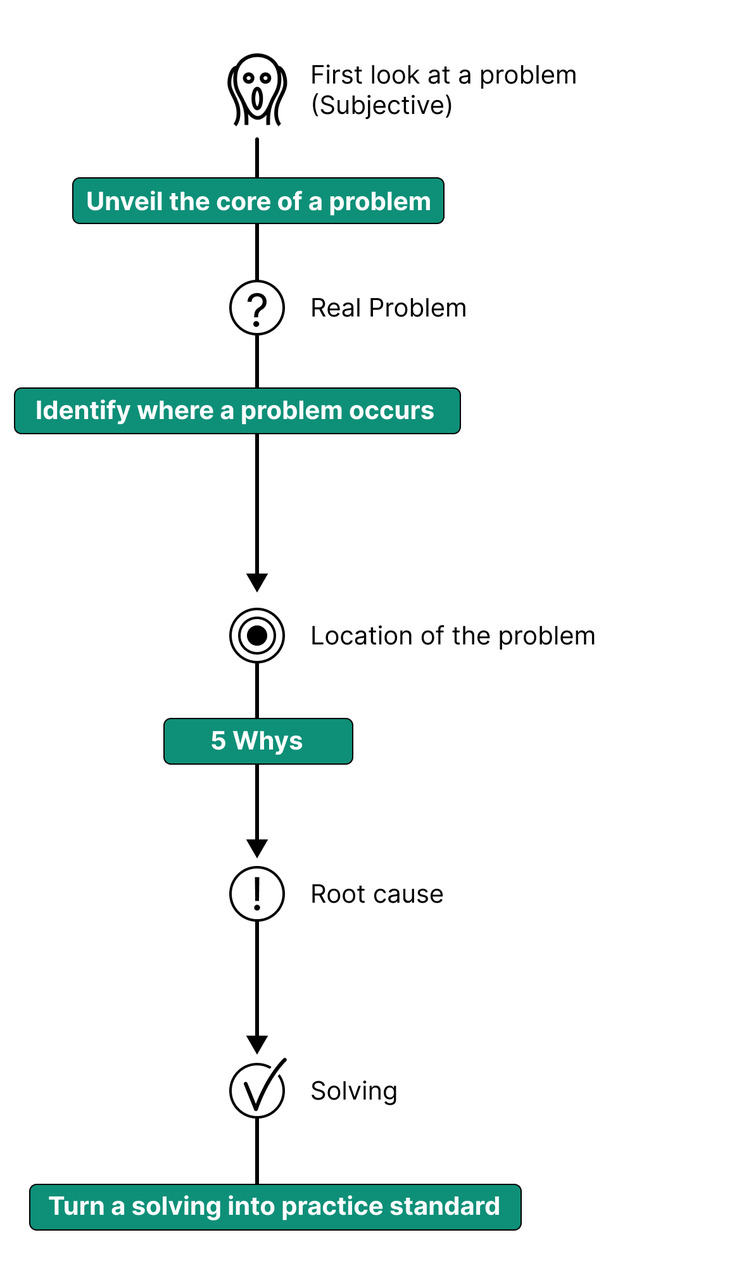
It also uses 2 tools — 5W1H to assess the situation and «5 why» to determine root causes and build cause-effect relationships.
In 5W1H you have to answer 6 questions:
— Who faced the problem (who)?
— What happened (what)?
— When?
— Where?
— Why did you have to do this (why)?
— How did the problem arise as a result of what actions (how)?
Additionally, then we work through «5 why». I first encountered this tool in one project where IKEA worked: when delivering defective products, you are forced to conduct an investigation and issue it in the format of «5 why».
The essence of the tool — you need 5 times to answer the question «Why did this happen?» to get to the systemic reasons. And the more digitized the business processes and all the steps, the easier, faster and more efficient it is to do this analysis.
An example of such an algorithm.
Problem: the goods came with scratches, while on the output control everything was fine.
— Step 1. Why is this happening? Because the products are damaged in the way, scratching each other.
— Step 2. Why is it damaged in the way? Because the transport is by car and side overloads are possible.
— Step 3. Why does the packed cargo still get damaged during transport? Because packaging technology doesn’t provide the proper protection.
— Step 4. Why does packaging technology not provide protection during transportation? Because packaging technology has drawbacks.
— Step 5. Why does the packaging technology have drawbacks? And here is the branching. The first is that there was no exit control before, and it was written off as a unit, no one was investigating the causes. The second is that the company had no prior experience with such delivery and that packaging technology was not developed.
The problem with this method is that it is necessary to maintain criticality and easily go into the wrong conclusions. Additionally, the above is a real example. Which one do you think is right?
In the digitization of 7 steps of problem solving — a key tool of lean production. Digitalization without software failures, hardware failures, conflicts is impossible, and you need to be able to solve these problems: localize and define the problem, formulate it, identify the causes of its occurrence, prepare ideas for solution, choose the best and act. Understanding and possession of this tool should be formed massively among employees. It is commonplace for them to formulate and describe their problem for technical support, rather than writing something of the category: «Good day, does not work 1C». It’ll save a lot of time and money. Because even if you decide to introduce artificial intelligence into technical support, it will not understand anything from such a request.
At the same time, without the described and structured processes, the effectiveness of the seven steps and the «5 why» will be radically reduced. How do you understand in what process the problem? Additionally, the main thing is that you will change, so that it does not happen again? Going forward, I will mark another tool — «6 sigma». It’s for you to understand the limits of the controllability of your process and not run to rebuild the whole organization after every sneeze.
5S — Control and Maintenance System
5S — a tool in an ecosystem of lean production, a method that aims at:
— increase the efficiency of the operation;
— eliminate accumulated waste and debris, including in IT solutions, and prevent its further occurrence;
— reduction of losses by searching for answers to the questions «where is the tool?» «how to access it?»;
— improving corporate culture through changing conditions and creating new habits.
The Japanese believe that the first thing is always to «dispel the fog», to make everything clear, signed, arranged in places. Then all losses become visible, and deviations are obvious, and can be quickly corrected before going into trouble.
If the workplace is a mess, then everything is «fog» where the losses are born.
At the same time, the essence of the 5S system — not only one-time restoration of order in the workplace, but also the maintenance of such order always.
5S algorithm:
— Sorting: All items in the workplace are separated (sorted) into necessary and unnecessary items. Unnecessary items are removed from the workplace. In IT, too: everything superfluous is removed from the system’s desktop.
— Keeping order: Items are arranged so that they are easy and convenient to use. Here we are talking about UX design.
— Cleanliness: all items and workplaces are cleaned, washed, painted, dirt, dust and debris removed, unnecessary graphics.
— Standardization: a visual standard is drawn up for the location of objects: contours of objects, signatures at their locations, cleaning regulations, desktops.
— Improvement: a system of continuous improvement of previous steps and the workplace is being developed. But without standards and «points of reference», everything will fall into chaos.
This tool also helps in designing interfaces for digital solutions, including for optimization. For example, some guys regularly monitor which functions are in demand, and put them in the first place. Additionally, what loses its relevance is sometimes cut out of the system altogether. Again, in IT systems, only 20% of the functionality is used regularly, 30% sometimes, and 50% — general garbage.
This is not a complete list of lean manufacturing tools. There are still:
— TQC — Universal Quality Control
— TQM — Global Quality Management
— TPM — Universal Equipment Care
— Just-in-time — just in time
— Report A3
You can read more about them by QR-code or link.
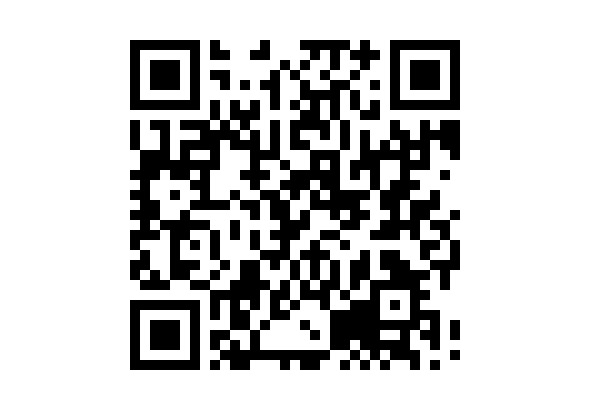
Disadvantages of lean production
— Problems of raw material and resource supply
Stock limitations make you vulnerable to suppliers, both external and internal. For example, if an employee is ill, some delays in logistics can be fatal. Additionally, as experience shows, sellers are very rarely willing or able to organize reliable deliveries in small lots on a tight schedule. If we add the current global chaos to logistics, then…
— Reputational Loss
This is a consequence of the previous paragraph. If due to suppliers will disrupt the technological processes, customers will not be able to receive their goods on time. Additionally, this is a reputation disaster.
— High Costs
If you introduce lean production completely, it may be necessary to reconstruct facilities, replace equipment, which is very expensive. In addition, the introduction of all rituals and tools will require long training of staff. Small and medium-sized businesses can end up paying off all these costs for a very long time.
— Employee resistance
The introduction of lean manufacturing, as well as digitalization in general, mainly causes stress and stiff resistance among staff. We went through the first book.
6 sigma
Six Sigma is the American approach to production management, where the main goal is to reduce the number of rejects to 3—4 units per 1 million units of finished products.
This tool is based on the processing of statistical data and the work with measurable indicators, which is generally characteristic of the American management culture. Here they say: «the right process gives the right results».
The main effect of using 6 sigma is the ability to distinguish the boundaries of the managed process. And in the case of detection of the problem to understand where is a system error and where is a private case, which allows not to treat force majeure excessive measures for the whole system. Just because one employee shows up at lunch doesn’t mean everyone has to be fined five minutes late. If there is one failure per million hours of work in an IT solution, it is not advisable to reassemble the whole system. Additionally, it is also a tool that allows us to identify, analyse and implement beneficial developments to improve the overall process.
Rule 3 sigma
Therefore, what are the «sigms» about?
Sigma (σ) is the letter of the Greek alphabet, which in mathematics denotes a standard deviation, that is, when indicators do not conform to this deviation, they are an anomaly.
Rule 3 Sigma states (in simplified terms): Virtually all values and results that can be considered normal for this process lie within a range of +- 3 sigma of the mean. If you plunge into the calculations, it turns out that all normal for the process results will be in these 3 sighs with a probability of 99.73%.
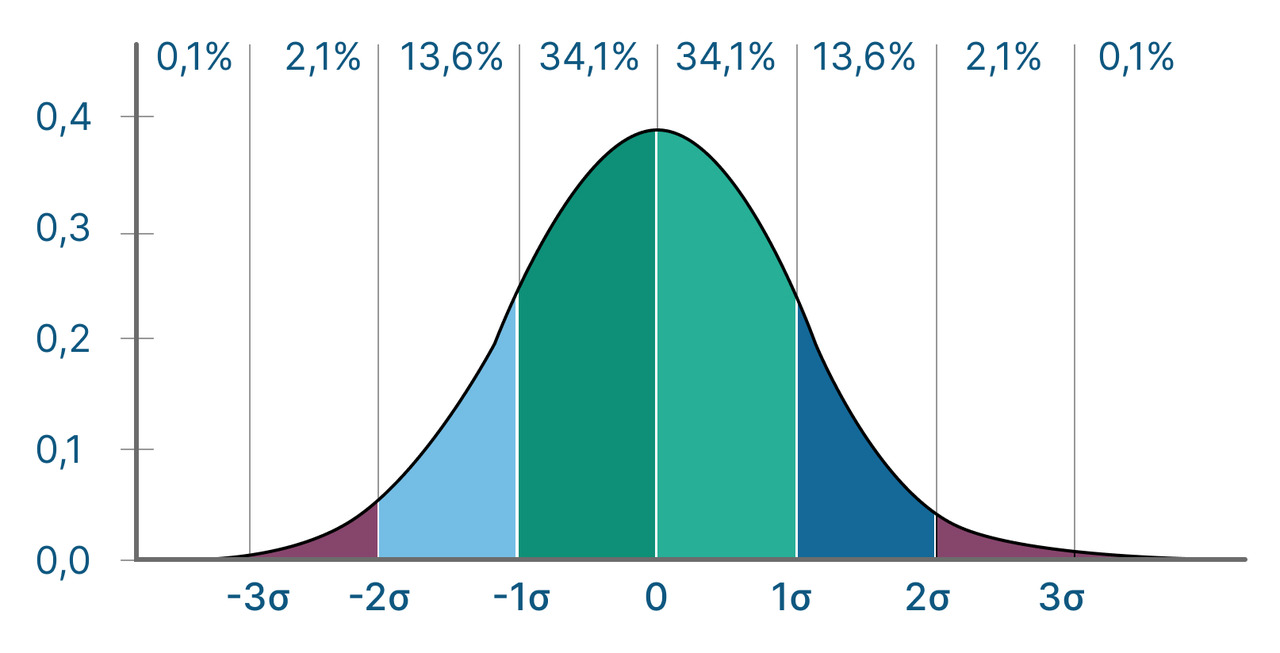
Algorithm of calculation 6 sigma
— Add all measured values and calculate the arithmetic mean.
— We consider the difference between the maximum and minimum values, for example, for a month.
— We consider the same difference for another, for example, 5 months.
— We calculate the average of this difference for 6 months.
— In Shuhart’s control cards (GOST R 50779.42—99) we find the index d2, and take the value for the sample, in our example it is 6 months, so d2 = 2.534.
— Take our average difference between maximum and minimum and divide by d2.
— We get a sigma.
— From the mean value of paragraph 1, we shall now defer 3 sigma to the right and to the left. We get six sigmas that show the boundaries of our managed process. What’s not inside is the deviations. We investigate the causes and work with them. Additionally, if we don’t like the boundaries of the process, we work systematically.
Of course, in life it is not always necessary to use all tools in full compliance.
Here’s a practical example from my practice.
What is on the input: the table with the data about the drilling of wells. Records in it about two hundred.

Additionally, on the basis of this data, it is necessary to understand what is happening at all? What are the problems? Unfortunately, it is impossible to conduct interviews with people.
Well, let’s go over a simple algorithm.
— Make a small panel in which we consider the duration of key periods.

— We calculate the main indicators.

— Then we build graphs of Pareto (with some clearing of anomalies), see what is the average wait between drilling and development (simple).
— Calculation and construction of the graph 6 sigma (but it is not necessary, all the necessary data is there). Defining the boundaries of a managed process and its current state. We find out whether it is necessary to make adjustments to the process or its complete restructuring?
— We determine the causes of deviations falling outside the boundaries of the process, including using the technique «5 Why». Determine whether processes need to be changed (e.g., procurement of ZIP).
— We also study the reasons for the best examples, determine the possibility of adjusting processes and setting new targets, standards. We also study the situation with the biggest downtimes, see who implemented, what went wrong, why. It is possible that there are the same people, and you need to work locally with them, for example, to teach them.
Yet, what conclusions could be drawn, even without deep calculations?
— According to Pareto’s schedule, we saw that in more than 75% of cases the waiting was within 73 days, and in 85% of cases — up to 154 days. Of course, it is better to calculate the sigma optimally, but in the current version the manageability boundaries of the process are visible. Accordingly, arithmetic averages can be used for the first approximation.
— We have no information about the depth of the wells and cannot assess the efficiency of the working process. However, we can compare the downtime between the end of drilling and the beginning of development. Thus, the average waiting time from the end of drilling to the beginning of development is 76 days. At the same time, the average expected start of development exceeds the average development period by more than 3.5 times and is comparable in time with the entire drilling process. The cumulative expectation loss is 42% of the cycle time from the start of drilling to completion. This generates both lost profits and direct losses.
— The reason is the system problems of the planning process, detailed audit is necessary.
— Possible system limitations:
— system of control and notification of the process stages;
— no system for forecasting the completion of drilling phases;
— lack of regulations and target values for the duration of each phase, notification time, delivery and readiness of the equipment for transition to development.
Here’s how one table can be calculated and learned to reach certain conclusions. As the informal communication showed, they were correct conclusions. However, I have not gone to the further project: the TOPs have been negotiating for almost six months, and in my opinion, if they do not know how to work quickly upstairs, something to change from below is meaningless. Everything comes from the head. In this I am convinced of every project, so I always start working from the first person. First we prepare it, and then we work with the team, only this approach gives results.
Lean Six Sigma
Lean Six Sigma — a hybrid that combines Japanese and American concepts:
— Lean Manufacturing (Lean) — Process Loss Reduction and Acceleration, Standardisation and Continuous Development, Working with People and Thinking;
— 6 sigm (Six Sigma) — Improving product quality and customer loyalty; the basis is information analysis, measurable performance.
In fact, as a basic education engineer, I think the best solutions are hybrids. There are no clean methodologies that are fully applicable to life. It is impossible to use any tool at 100%, it becomes redundant and too expensive pleasure. The calculation of boreholes given above took me one evening. As a result, I got an understanding of the problem. Could you go deeper, spend 2—3 nights on an analyst, but would change from this end result? Unlikely. Additionally, this is already losses in lean production — excessive processing.
Chapter Summary 3
Of course, not all the tools are listed here, and in the same 6 sigm concept you can go deeper to the control cards Shuhart, DMAIC, DMADV, what are the roles of the staff (green, black belts, masters, etc.), and in lean production — SIPOC and Poka-yoke, «House TPS» (tools and principles), but I think it would be a bit much for you, my reader. You’re not an executive, you’re a supervisor. That means that your people need to know the specific tools, and you need to understand how it works to be able to set the right tasks and delegate, control and ask for the result.
The main purpose of this chapter is to diffuse the fog before the mysterious thrifty production and show that it is an excellent tool in an integrated management system. Additionally, if we first optimize lean manufacturing processes and then use digital tools to focus on eliminating losses and working with people, collecting feedback from them, the effect of this approach will not be measured in a few tens of percent, several times.
As I mentioned the example, understanding what losses should be eliminated, how to collect information from the bottom and support it sometimes with free tools, you can save business millions of rubles. So, in 4 months we completely excluded unearmarked work from the production manager, and this is more than 1 million rubles a year, while he began to do what he should — the organization of the work of the division. Same goes for the foreman.
If it is still interesting to go deeper, then the QR code and link will lead to the corresponding article.
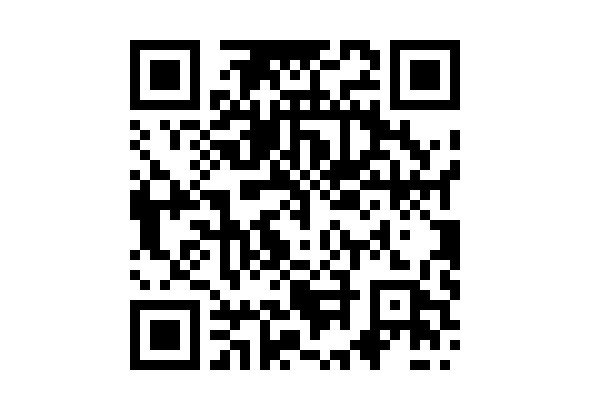
Chapter 4. Project management
Introduction
In general, digitalization and digital transformation are a project in themselves. When you want to do something, you haven’t done before, when you’re limited in time and resources, it’s a project. You want to write a book, buy a car, go on vacation to a new place, that’s a project. You start a new business; you decide to change the department — it’s a project.
Project management is like riding on rides: sometimes fun, sometimes exciting, sometimes come out with full pants. If the control becomes chaos, then it is clearly not fun and you can lose your pants, especially given the cost of digital technology.
Any project consists of stages of initiation, planning, implementation (control) and closure. Additionally, for each stage there are tasks. Plus, you have to choose the right implementation methodology and remember that the project is a triangle.

The essence of this triangle is that you cannot change the content of a project (except in rare cases) without changing the timing or budget. Or you cannot reduce the term without changing the budget (to attract additional people, for example) or maintenance. That is, any your wish will necessarily affect the content, timing or cost.
Let’s talk about this. x4x4
Project management is best characterized by the Russian proverb «long harness, fast drive». Additionally, if you don’t, miss the first stages, then you will be in one ditch, a cart in another, and the horse will run away.
According to my personal observations, the majority of projects suffer from poor management. Let’s say that you have correctly identified where to implement IT, the technology itself, the key effects, but here comes the introduction and…
To be frank, it was with project management that my path in digitalization began, and it was this direction of management that I mastered the most deeply. As a result, I have experience with both startups and giants: LUKOIL, Gazprom, Ministry of Energy, Mazda-Sollers. Additionally, I can say with certainty that in industry we do not know how to manage projects: choose the wrong organization. structures, methodologies, focus on formal tools, do not elaborate goals, objectives, resource availability, risks… However, don’t think we’re alone. The Standish Group has reached the following conclusions about the causes of project failures after having studied more than 50,000 projects worldwide:
— Lack of Resources
This is a typical story — let’s initiate the project, and how to implement, we will understand later. So, I had a project in one corporation that involved 7,500 people, which we accompanied with the help of Excel. Should we talk about this fun adventure, and what quality of data was there?
— Unrealistic Terms
I think everyone knows «had to yesterday». Unreal deadlines are not so bad if we keep in mind that they will be disrupted, and try to become better. However, as practice shows, this approach is almost not followed.
— Errors in the formulation of the objectives
As a rule, the objectives are either vague or vague, and there is an error in the causal relationship, and the objectives do not reflect the objectives to be achieved.
— Not enough detailed planning
If you think about it, this is the reason for all the other points.
— The quality of interaction within the team is poor
Unfortunately, within corporations, people are used to formal communication, through notes and correspondence. Additionally, most problems could be solved simply by normal communication before the aftereffects.
— Change of objectives during the project
Again, with proper planning of the initiation and planning stages, this can be avoided. After all, people are extremely poorly tolerated by chaos and uncertainty.
Project management statistics
First of all I want to give a diagram of the statistics of project management.

Moreover, if you dive deeper into research, then from the 1990s to the early 2000s, the dynamics were positive, and then everything stalled. Even by industry, the situation does not differ significantly.
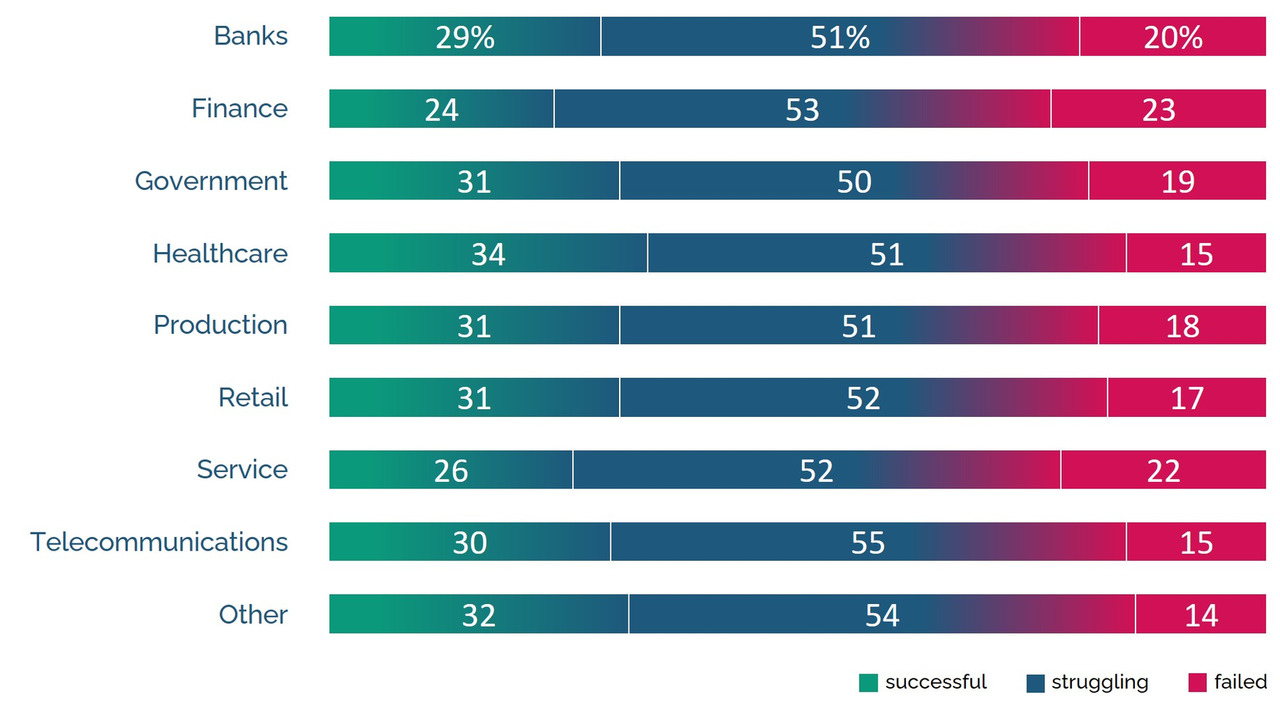
The dependence of success on project size and methodology
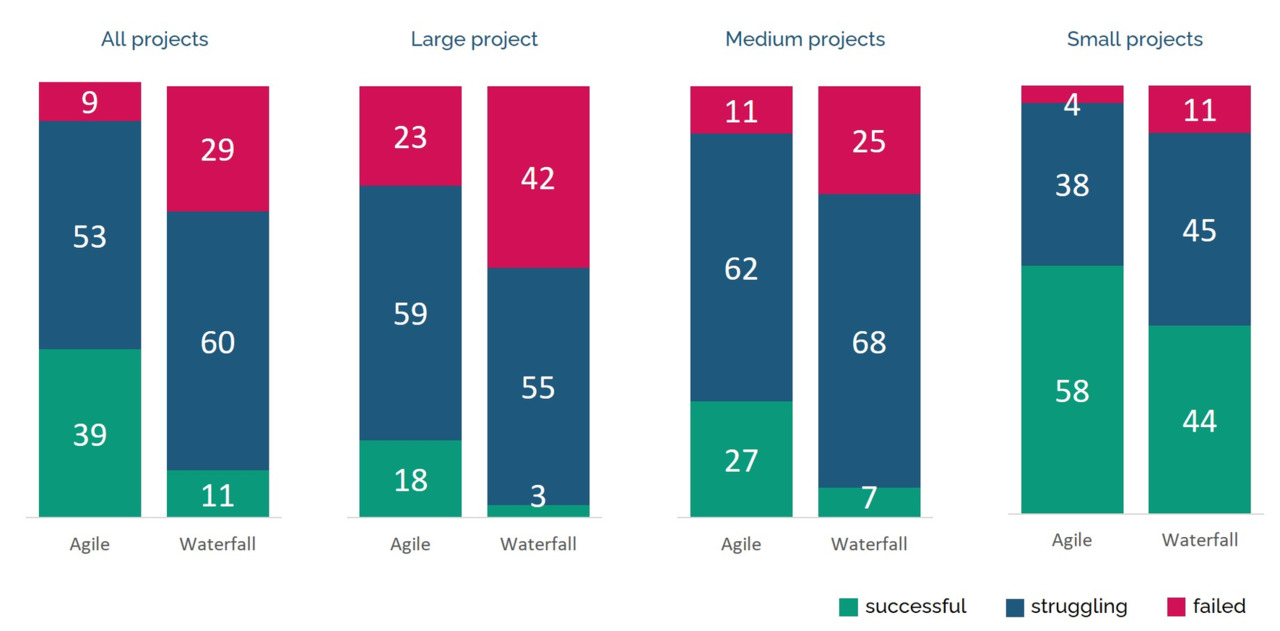
Let’s look at our companies. All gravitate to mega projects and, preferably, on a cascade (waterfall) model. What it is and what is the difference, let’s analyze in this chapter.
Even more interesting are the statistics on time and cost overruns.
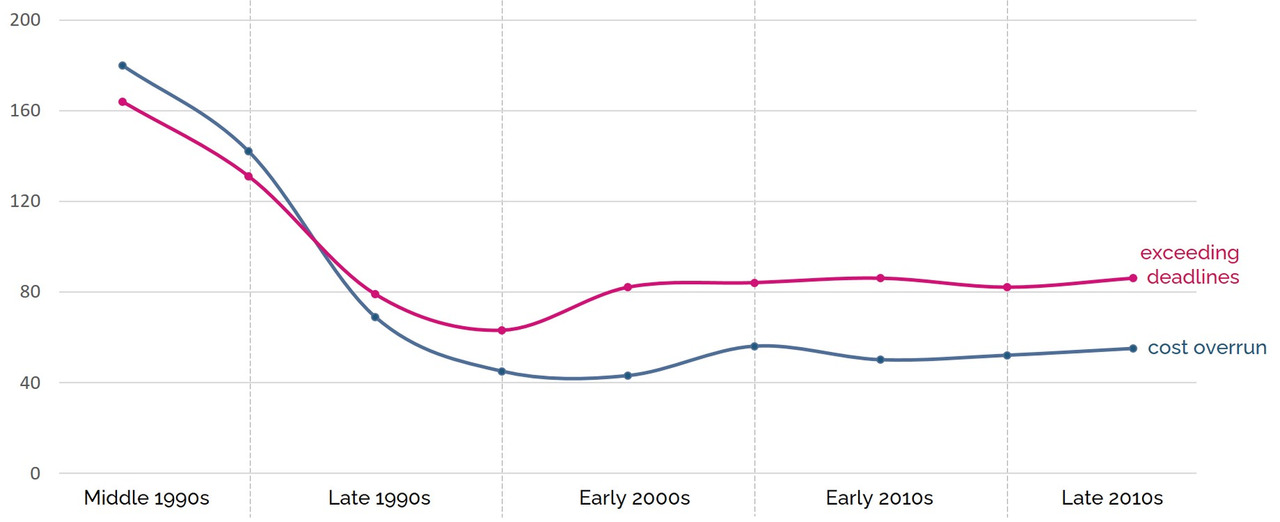
That is, on average, the budget is over half, and the timeline — almost twice. And this is exactly what project managers say informally.
It turns out, in order to successfully implement projects on digital transformation, it is better to do not megaproject, but a large number of small on flexible methodologies. It’s unusual, isn’t it? It requires a completely different corporate culture than what we’re used to seeing.
At the same time, the competence of the project management becomes more and more obligatory, it cannot be ignored, and here is why:
— the share of projects in GDP, for example, in the UK, increased from 5% to 35% in 100 years;
— the global trend is not to sell individual products, but complex projects. And we are behind in this direction for a whole generation. If everyone comes to the fact that it is necessary to sell not a gas turbine, and service turnkey, with delivery, installation, all auxiliary equipment, maintenance organization, we still sell the iron, and then — the customer’s care;
— according to some projections, by 2030 up to 60% of the time of a top-level manager will be spent on projects;
— at the same time, according to the recommendations of the standards and my observations, mistakes made and not corrected at the beginning of the project can be guaranteed to bury it. I’ve been through dead projects, and I’ve been pulling out «troublemakers». The cost of the same changes increases from 10 nominal rubles at the initiation and planning stage to 10,000 at commissioning. The ability to correct errors is reduced. Therefore, modern methods provide for up to 30—40% of the time of the entire project for its planning and risk development.
Possible approaches and standards for project management
In the world and in particular in Russia there are several standards and approaches to project management:
— Standards on the competence of the manager:
— ICB standard from IPMA (International Project Management Association);
— STK standard from OWNET, which is a translation of ICB.
2. Standards that build processes:
— PMBOK from PMI
— ISO 21500 from ISO is a summary of PMBOK (100 pages instead of 500+)
— P2M from PMAJ — both pro and pro projects. Focused on the values that should get by the end of implementation.
— Prince2, developed by the authors of ITIL, a standard for the management of IT services.
There is also Agile as a set of principles and tools aimed at flexibility in the face of uncertainty and the need to test hypotheses, with a powerful psychological basis within.
If simplified, the approaches to the implementation of projects can be divided into:
— Waterfall model;

— hybrid;
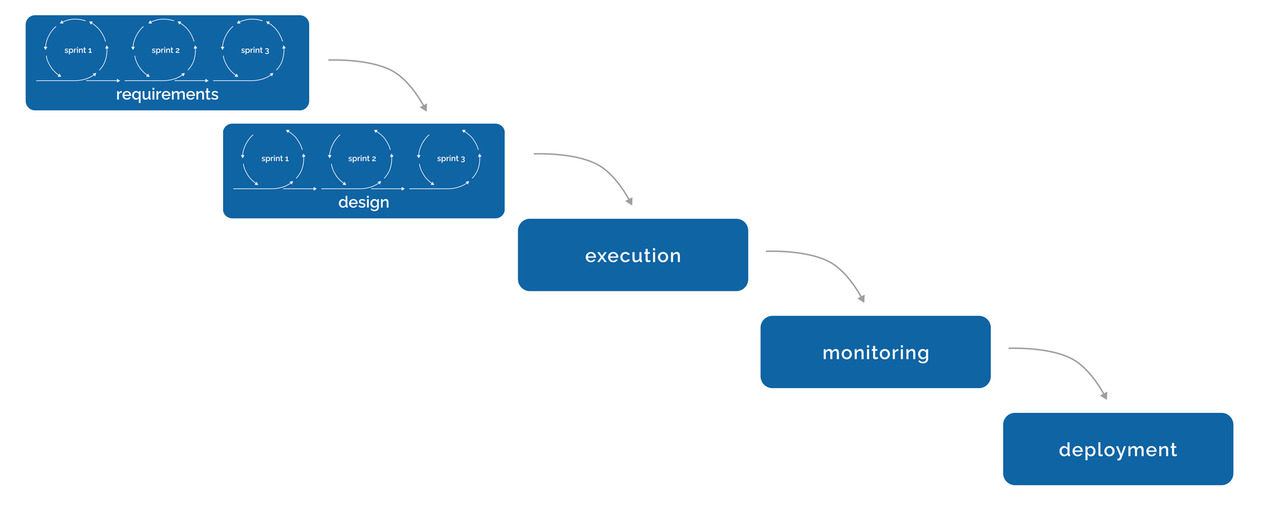
— Agile.
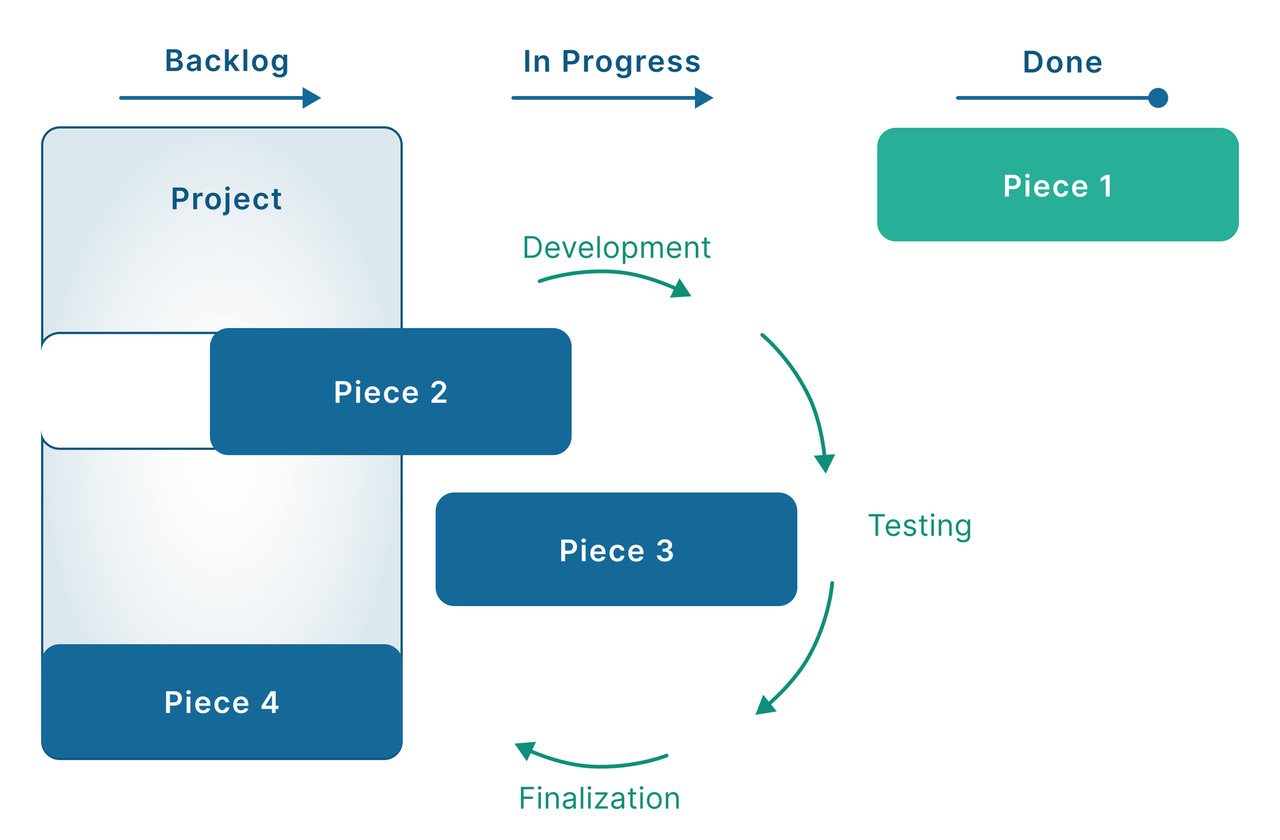
In turn, flexible approaches can also be decomposed into 3 types: iterative, incremental, iterative-incremental.

At the same time, according to various studies, in life mostly (60—70%) used hybrid methods. Pure approach is very little, and it is normal, because it is impossible to create a universal tool for all occasions.
How to choose the right approach?
Before going through the basic approaches, I want to share one, essentially, key tool that allows you to understand at an early stage which project is in front of you, which standard or hybrid is more appropriate to apply.
It is a Kenevin model (Cynefin framework) that distinguishes five types of systems: Simple (Simple), Complex (Complicated), Confusing (Complex), Chaotic (Chaotic) and Random (Disorder).
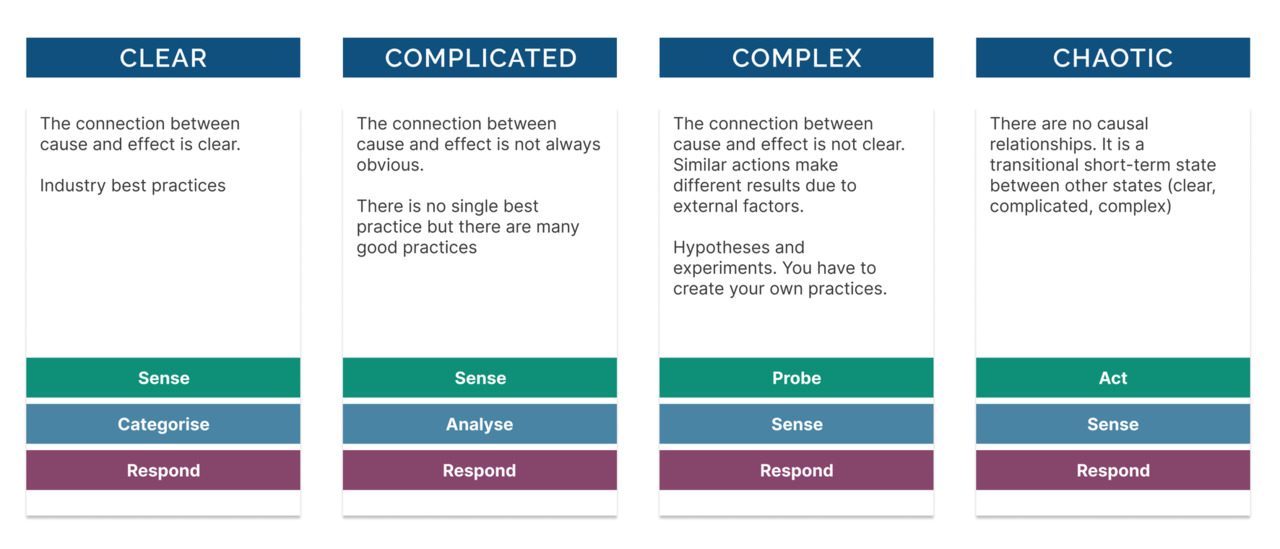
1. Simple system
Characteristic: Causal relationships are clear and unambiguous.
What we do, we get the best practices.
Order of Action: Understand — Classify — React.
Examples: repetitive and relatively simple projects, such as paving the sidewalk in the yard, webinar.
You can use any «cascade» standard. The main thing — not to be seduced by simplicity and do not neglect planning and points of control.
2. Complex system
Characteristic: Causal relationships exist but are not always obvious.
What we do: we use good practices and standards. There is no single «best practice», but there are many «good practices».
Action Sequence: Understand — Analyze — React.
Examples: ERP system implementation, production line reconstruction.
Here you need to comply with the requirements of PMBOK, Prince2, P2M, work with stakeholders and risks.
The «flexible» methodologies could lead to unreasonable budget overruns and delay. However, they can be used as part of a «hybrid» approach.
3. Complicated system
Characteristic: Cause-effect relationships are not clear. Similar actions lead to different results due to external factors.
What we’re doing is, there’s a field for hypotheses and experiments. In such systems, it is difficult to rely on historical information and individual observed facts. It is necessary to invent the practice of achieving results.
The order of action in this environment: Explore — Understand — React.
Examples: developing a new mobile app, entering a new foreign market, creating a bill in the field of artificial intelligence.
This is the territory of Agile and Scrum. Clear technical tasks do not fit here. Flexibility and awareness of risks, deviation from strict requirements are needed.
It will be a lot to communicate with the customer. As a rule, he himself does not fully understand what he needs. The final product may differ significantly from the original plan.
This is one of the reasons for the problem of IT implementation in large companies. Everything is done on paper, with budget restrictions. As a result, they come to uncomfortable and expensive in content and no budget for improvement, which is explained by the following points:
— Made according to the original requirements, which means the project can be considered successful. What other investments can be made?
— In bureaucratic organizations, it is almost impossible to grasp the fallacy of original desires or of understanding what is really needed. And when the mistake is finally revealed, they look for the culprit to punish.
— The limitations of budgetary rules. Who has faced this, understands what the problem is and how much it consumes time.
4. Chaotic environment (crisis, innovation)
Characteristic: No causal relationships. This is a transient short-term state, either to simple or complex systems (by means of strict restrictions) or to a confusing environment (by means of point measures).
The order of actions in this environment: Act — Understand — React.
What we do: The first step in chaos is action. The goal is to reduce chaos. Then it is necessary to feel the result of this action and to react in order to transfer the system from a chaotic state to a confusing or ordered one. There’s just no time to test hypotheses, and chaotic systems are incredibly fast.
The result depends on the literacy, courage and innovation of the thinking of particular managers.
5. Disorderly environment
It is particularly difficult to recognize because of the many competing options. The recommendation is to divide it into parts and to determine the context in which each of the parts relates.
Types of organizational structures
To choose the right project management standard, you need not only to determine in which environment it will be implemented, but also the type of your organizational structure:
— Weak — a lot of projects, but they are small, without routine, not critical for the company. Or just one project that purposely takes 10—20% of the company’s resources. If you look at the model of Keenevin, it is suitable for simple systems. Such a structure is particularly demanding to develop a communication plan between the participants and to receive feedback from the project manager, who is usually not a senior manager.
— Balanced — medium projects that can take 20—50% of the company’s resources. If you look at the Kinevin model, these are complex and confusing systems. You can also apply to chaotic structures, but you have to evaluate the project. For example, implementing an ERP or separate digital projects.
— Strong — strategic projects where the price of error is high for the company, and a large number of resources (more than 50%) is required. These are, for example, transformation programs, complex automation, implementation of lean production systems and so on. Here, it is essential to work through the initiation and planning phase, to make short milestones between phases and to remain flexible.
— Next, we will look at all the basic standards that underlie all approaches. This may seem superfluous to you as leaders, but through understanding the tools you will be able to choose the right one. Additionally, for the executives of large companies, this will allow more effective management of the team and not collect bullshit, which is often tried to hang particularly smart managers.
Project implementation methodology
PMBOK
PMBOK (Project Management Body of Knowledge). In Russian, it is a «collection of knowledge about project management». Process classifier (until 2021), which says that and when to execute in order for the project to achieve its stated goals.
This code is the result of Americans’ work in their desire to create a universal instruction manual. They wanted to move away from the human factor in management and to ensure that anyone who took this instruction could implement the project. The PMI (Project Management Institute — Institute of Project Management) certifies the volume.
PMI also issues a PMP (Project Management Professional) certificate. Additionally, it’s the certificates that this organization wants to see from project managers in big corporations.
PMBOK is the most common methodology that can be used in most projects.
This approach was the first to introduce the concept of a «project triangle» which describes the balance between cost, time and quality of the project.
Бесплатный фрагмент закончился.
Купите книгу, чтобы продолжить чтение.